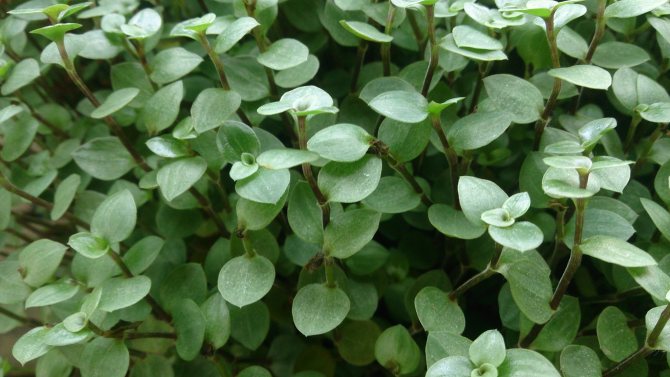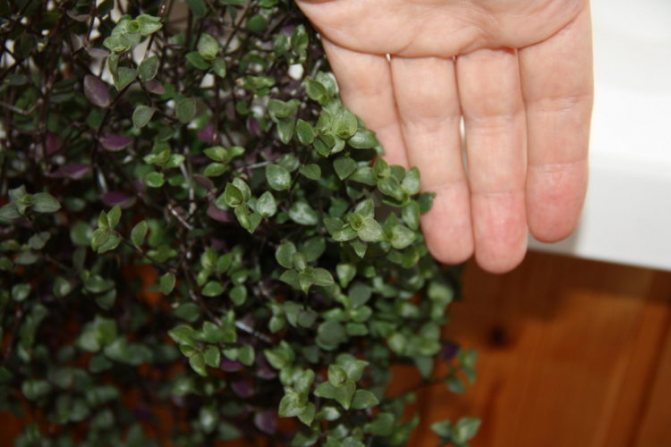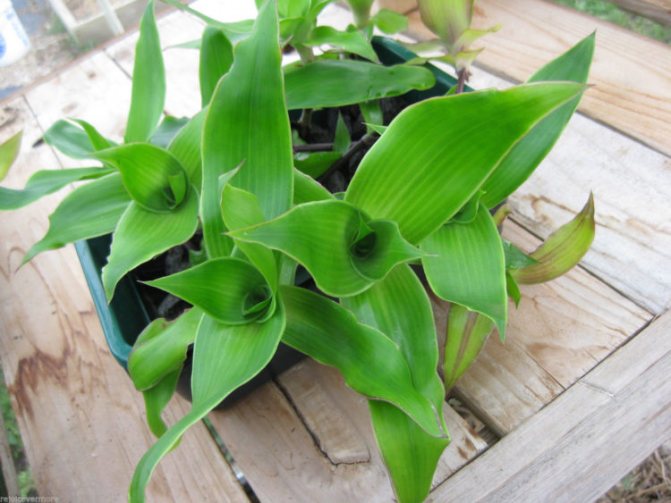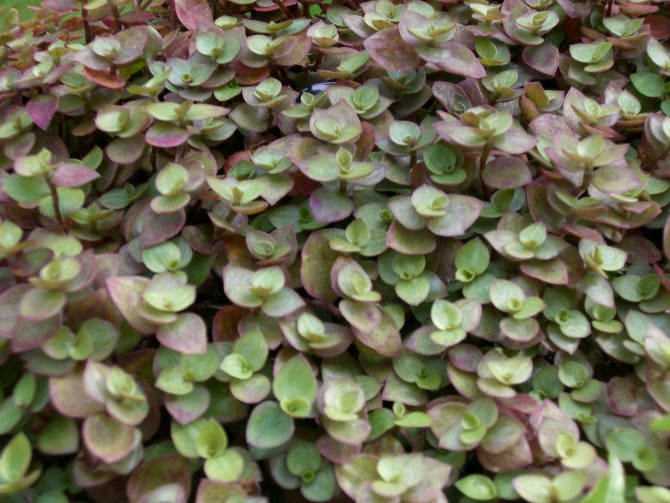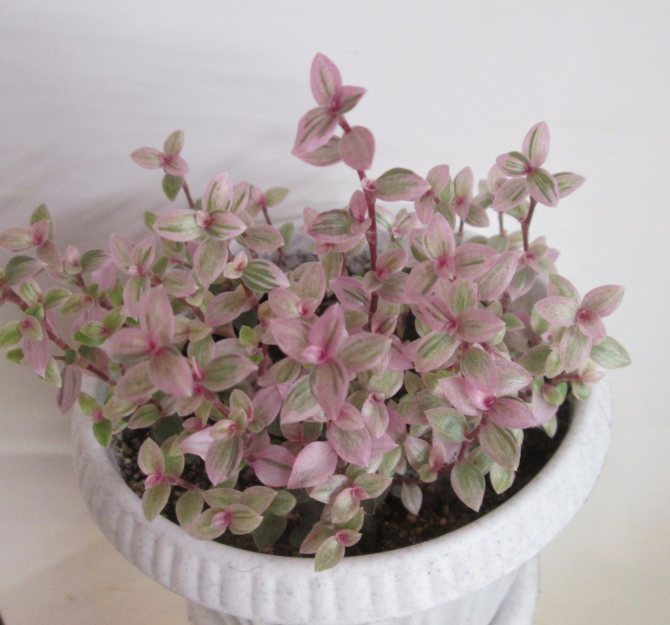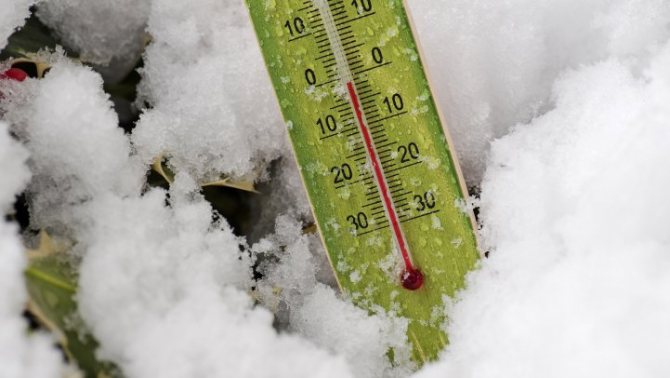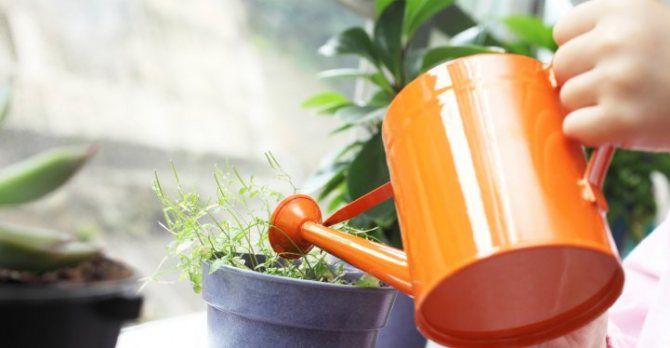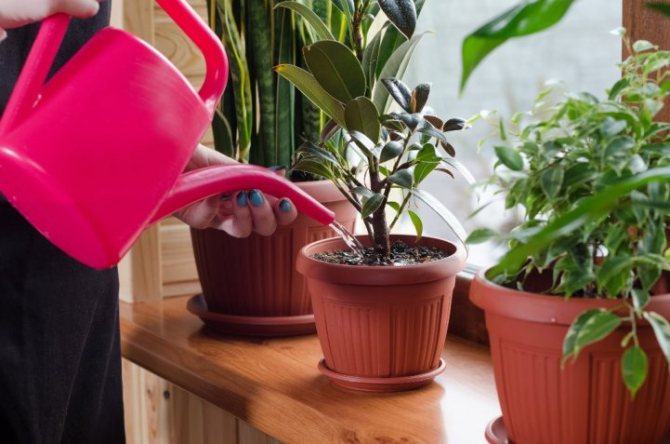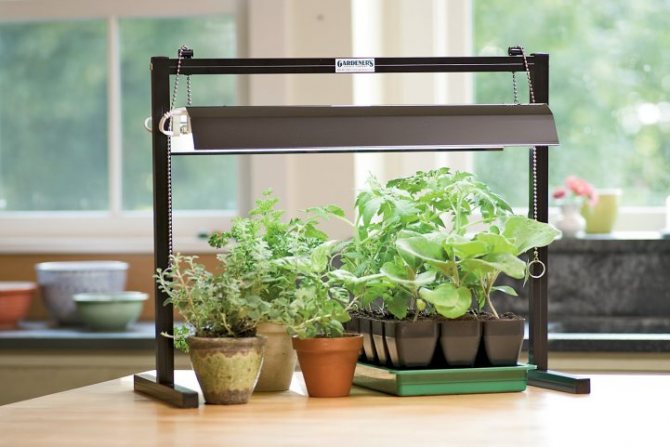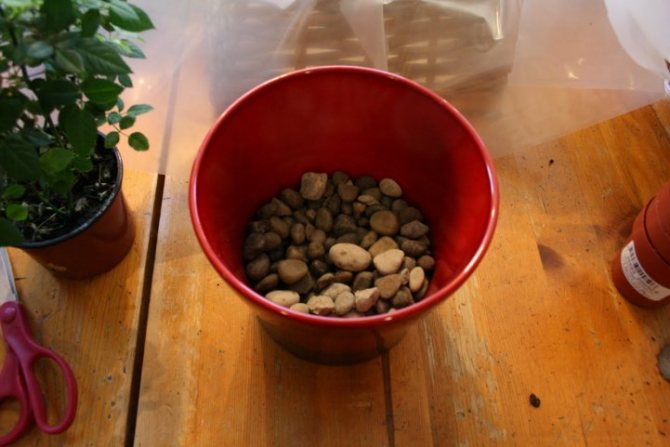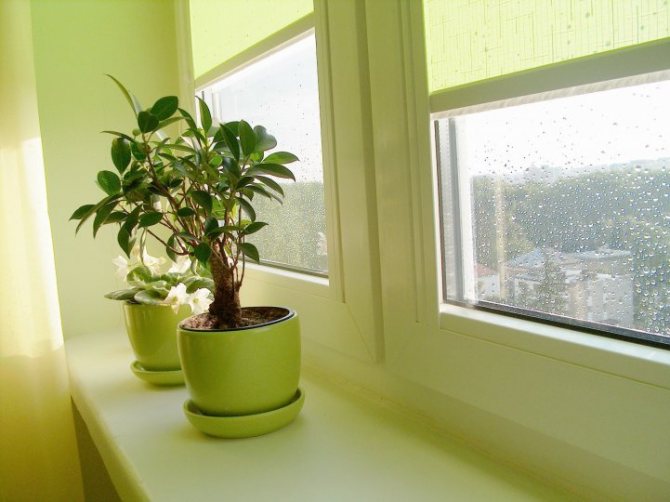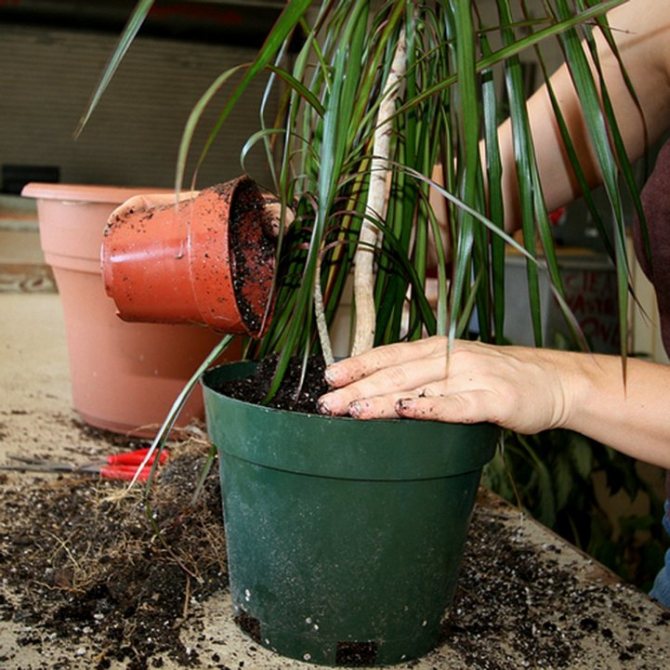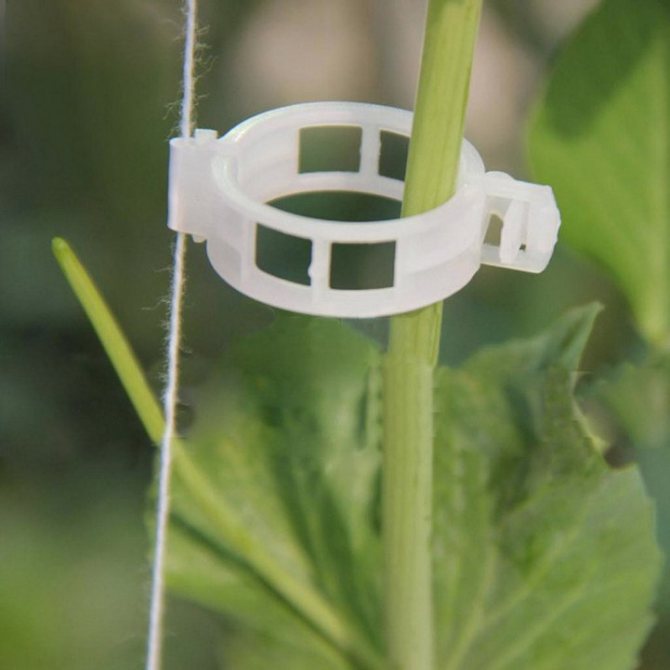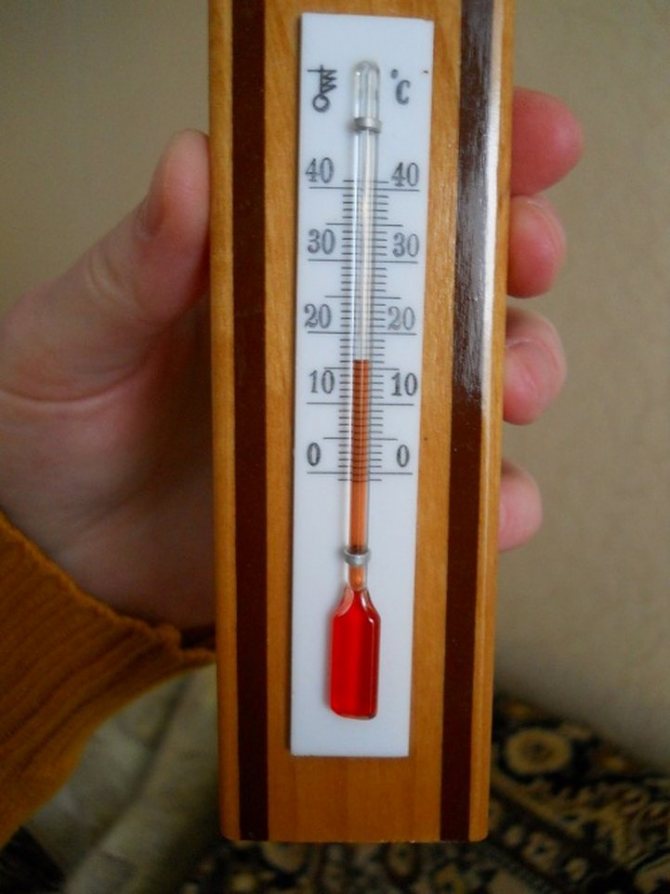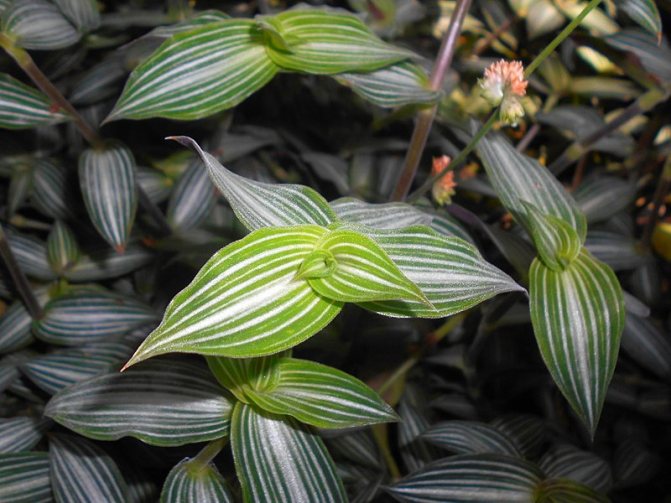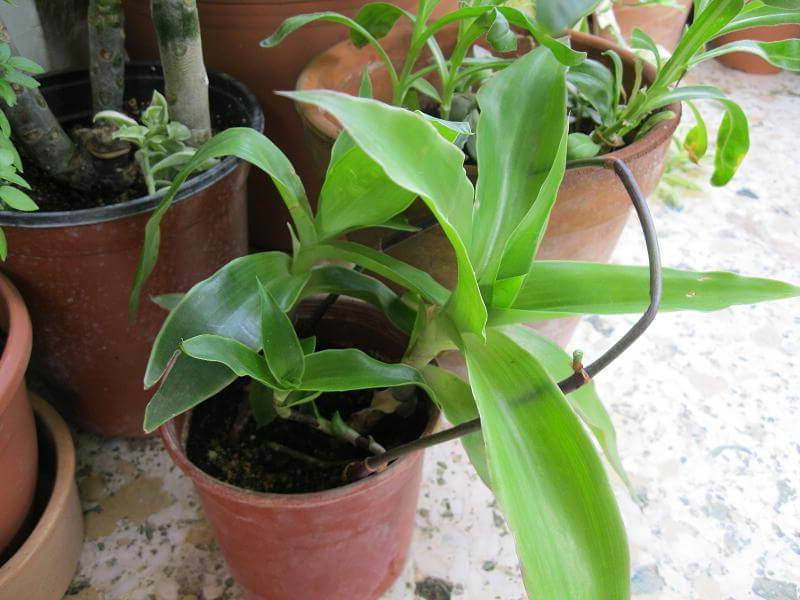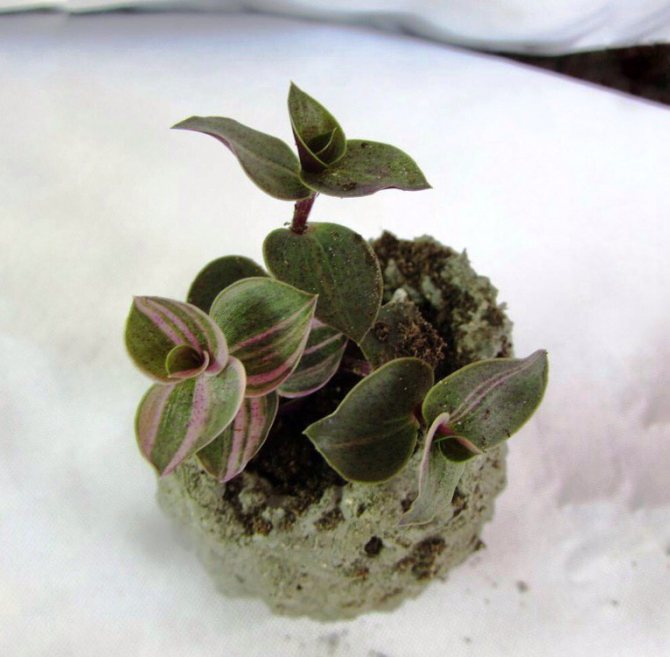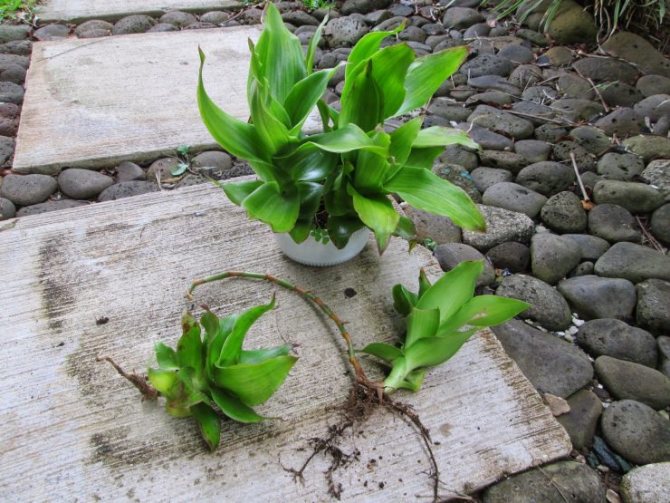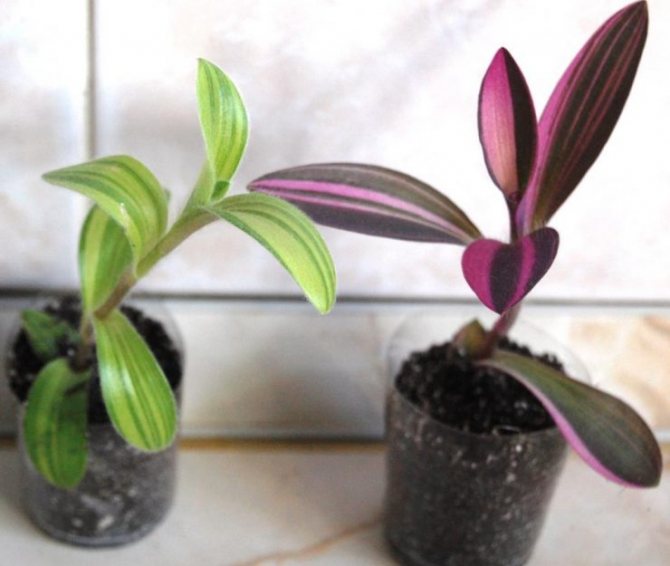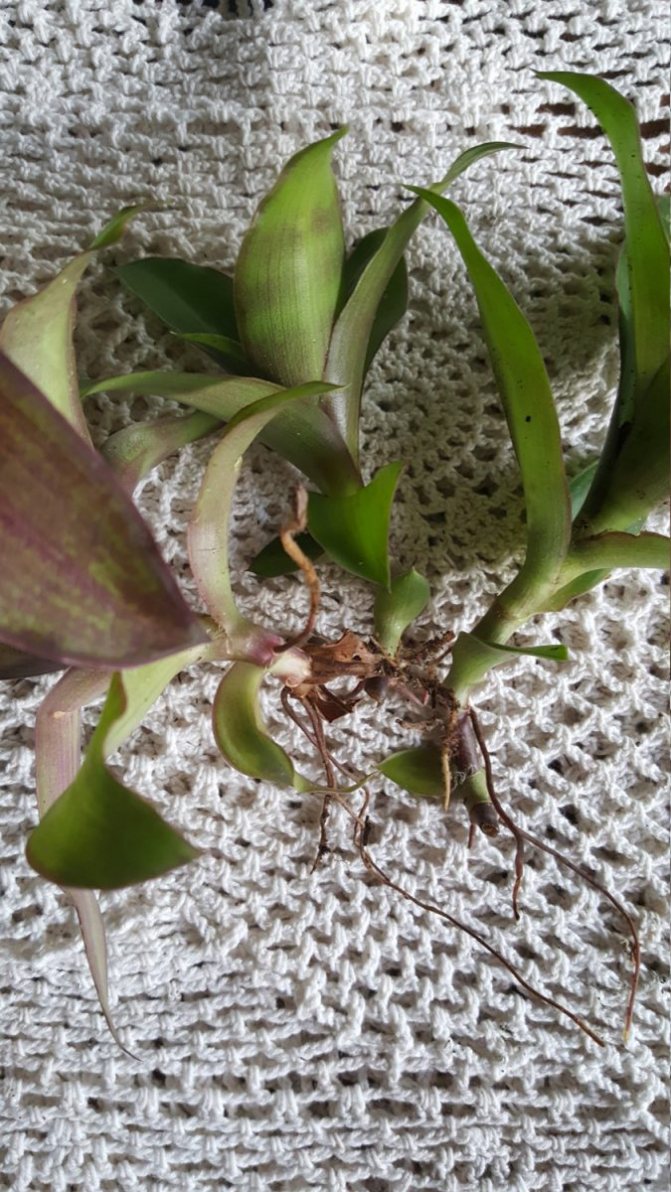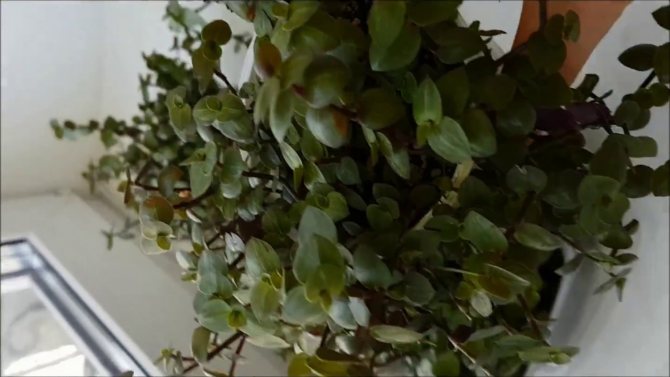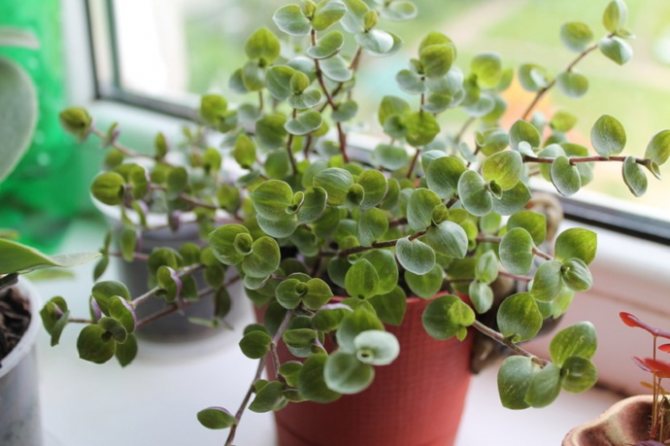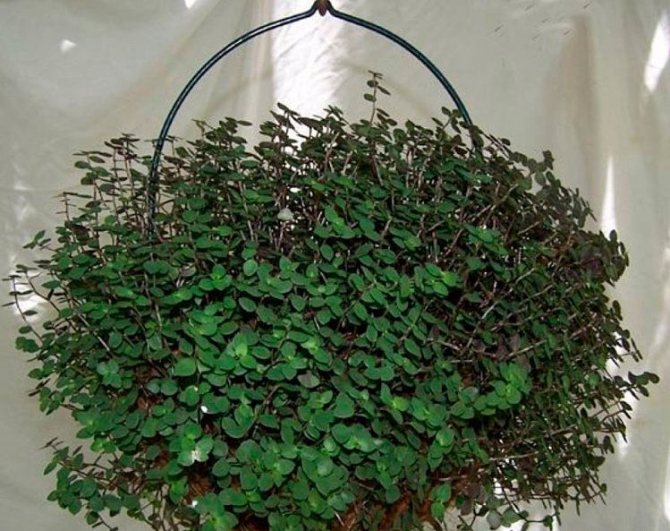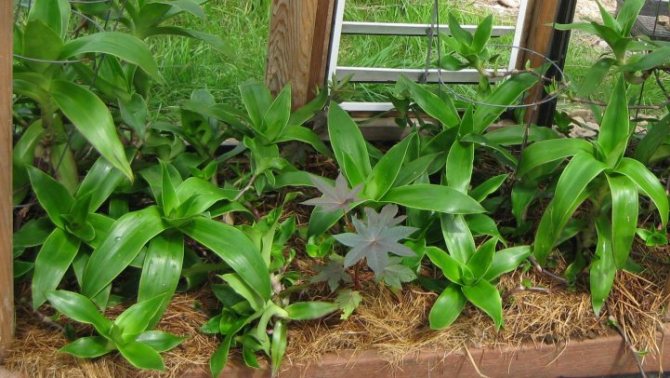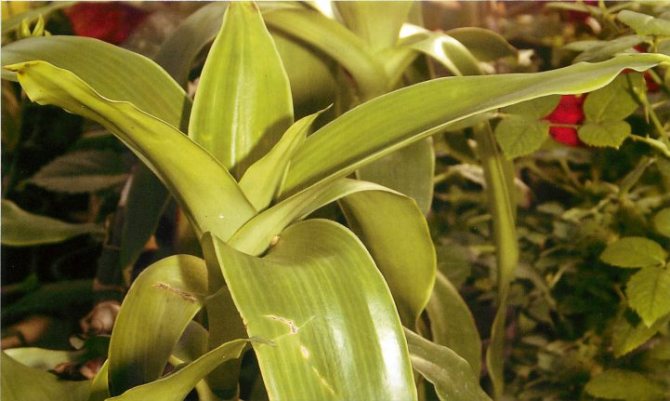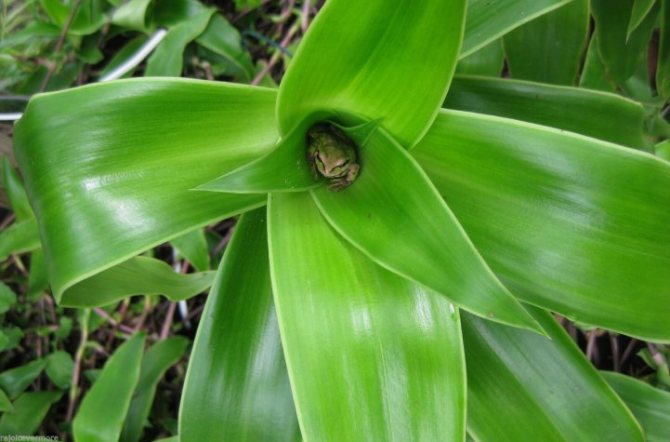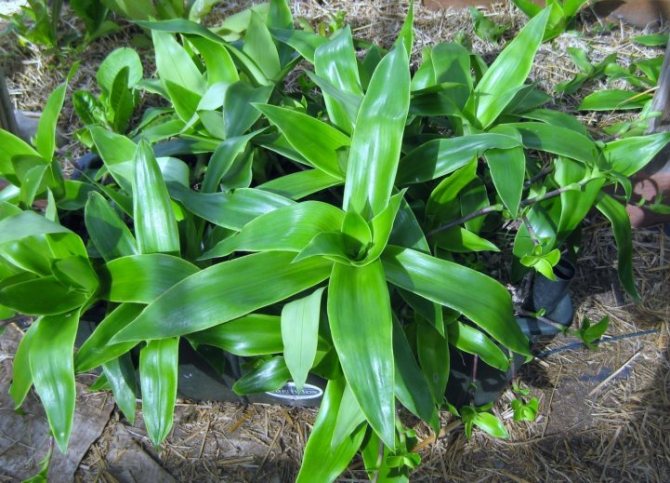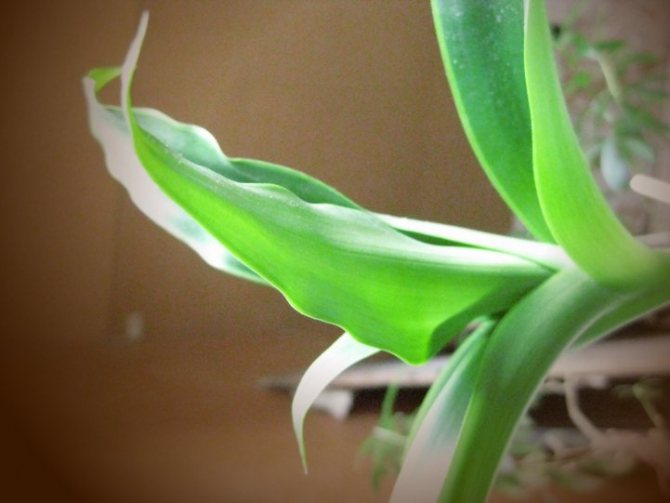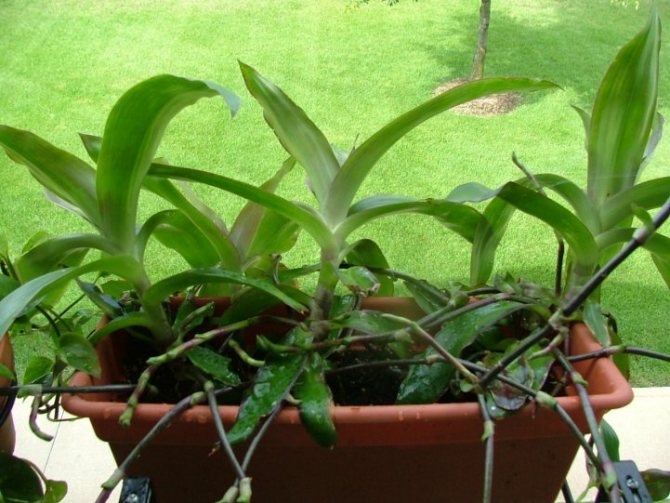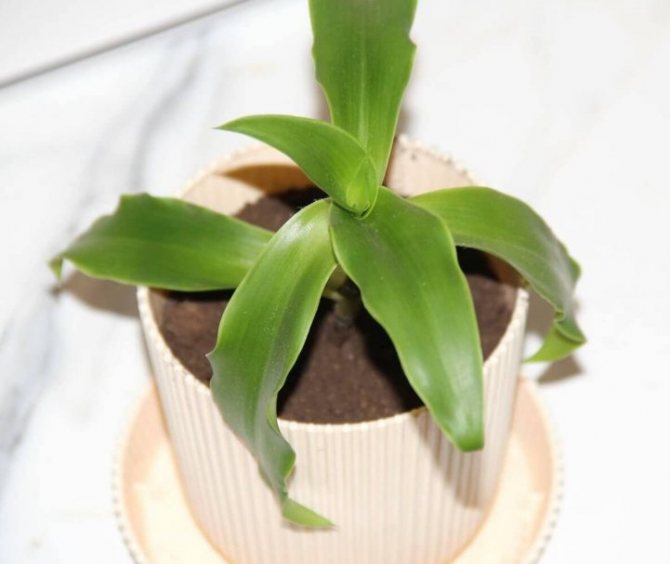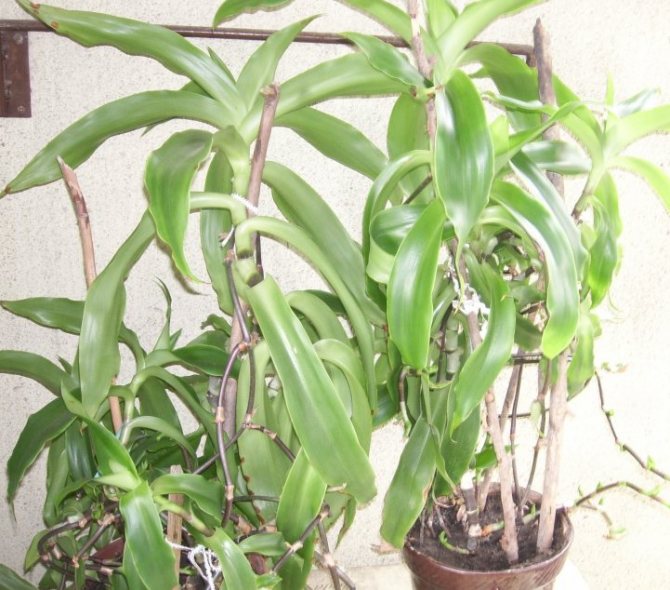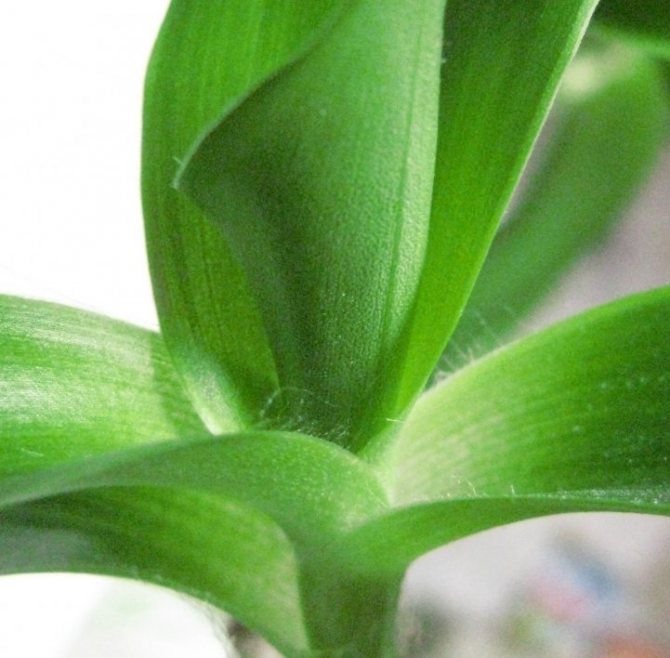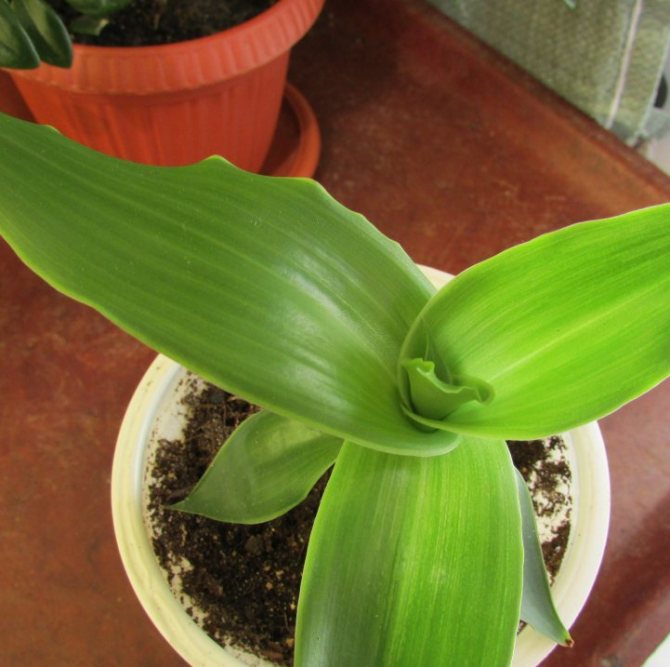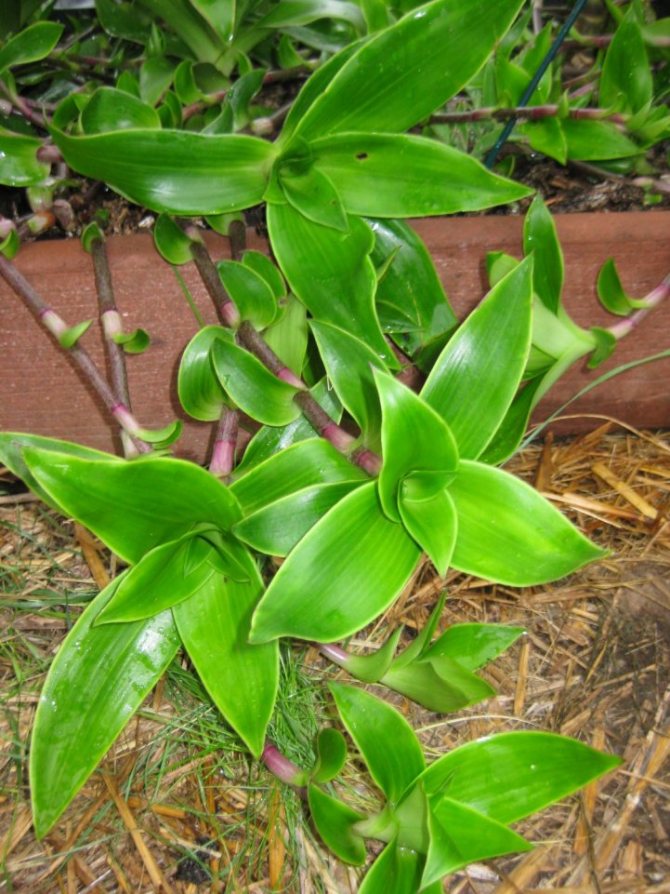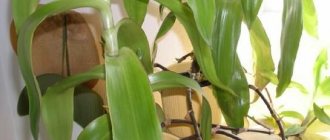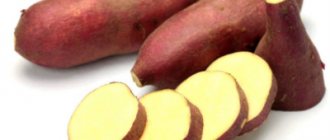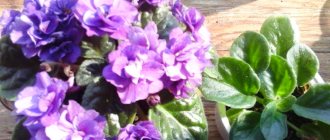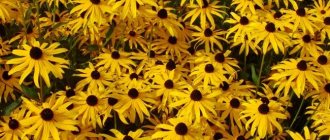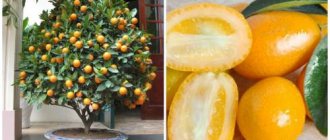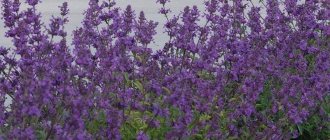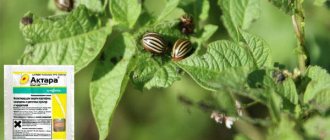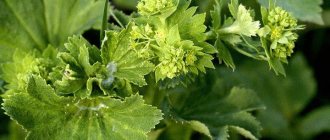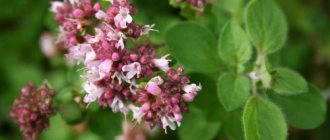Fragrant callis, or golden mustache, is a tropical perennial that is actively used not only in floriculture, but also in folk medicine and cosmetology due to its beneficial properties.
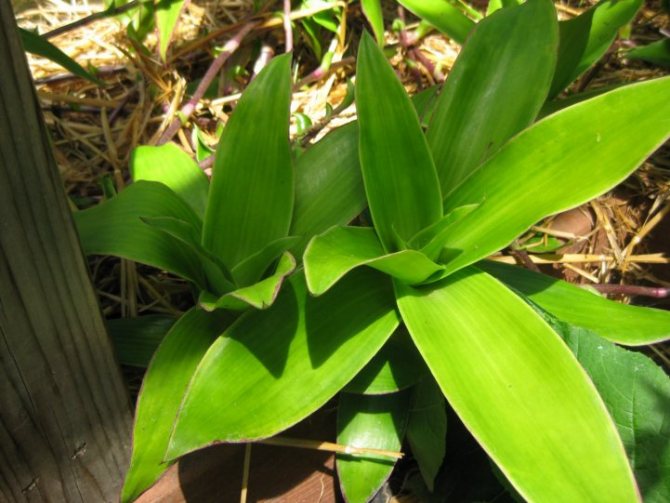
The plant is rich in biologically active substances, such as:
- vitamins (C, A, PP, B);
- flavonoids;
- phytosterols;
- trace elements (potassium, calcium, iron, copper, magnesium, chromium, etc.);
- antioxidants.
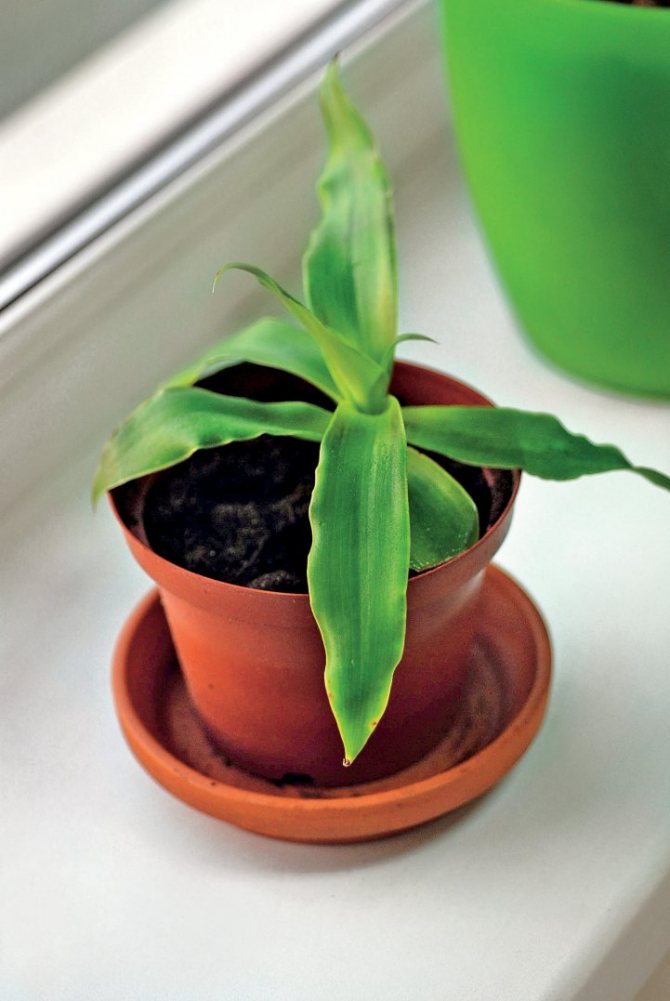

It is not difficult to grow callis at home. With proper care, the plant can grow up to 1.5 m in height and up to 120 cm in width. The length of the leaves is up to 30 cm, they are dense and fleshy.
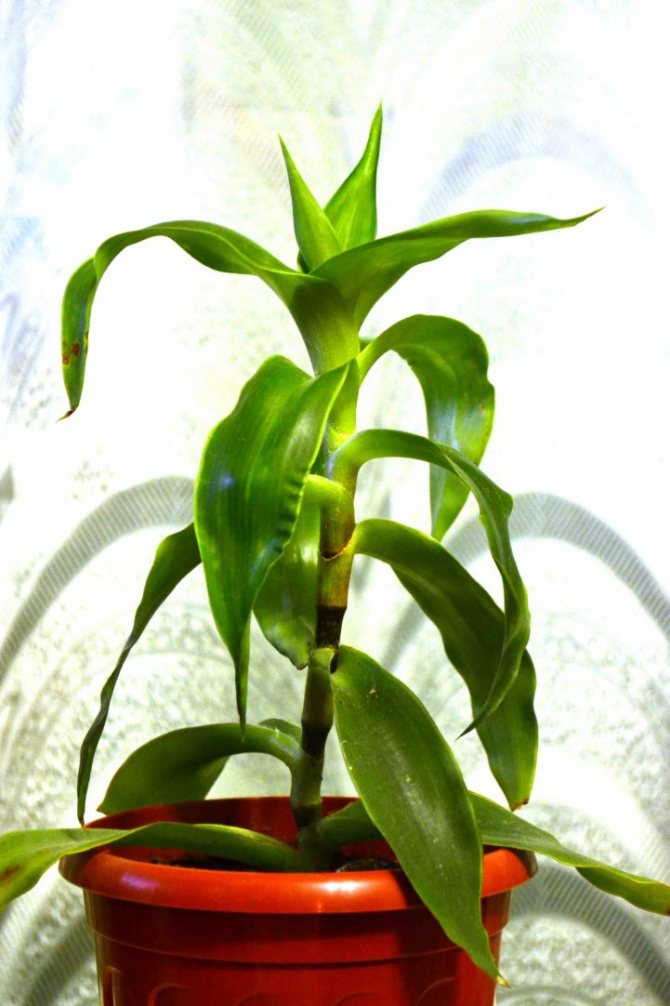

The flowers are small, pink in color, with a delicate pleasant aroma. The plant blooms only when growing conditions are met.
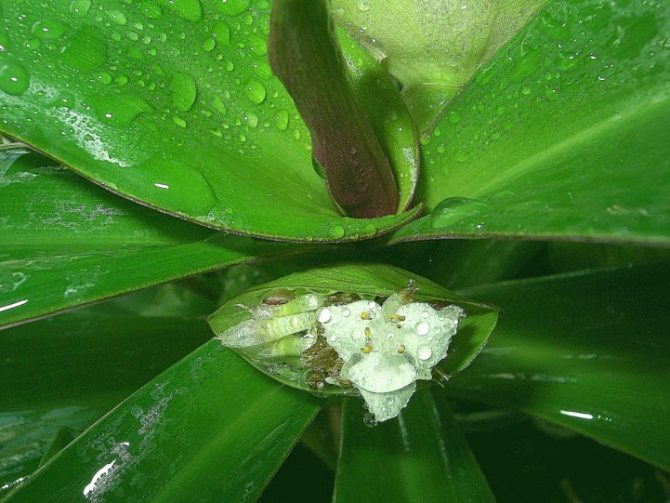

Golden mustache care
A golden mustache is a plant that does not cause trouble for its owners and is not whimsical, loves bright, but diffused light, moisture and warmth. A suitable temperature for growth will be + 25-27 degrees. With insufficient light, the leaves of the golden mustache may turn pale, and the plant itself will stretch, but it is not necessary to put it in the bright sun. In winter, you need to ensure that the temperature does not drop below +10 degrees. At this temperature, callis passes into a dormant period. Abundant watering is necessary for the plant with a golden mustache, which is cared for in spring and summer. The ground should be constantly moist, but no stagnation of water should be allowed. In winter, reduce watering, but prevent the earthen coma from drying out. Spraying is good for the plant, which must be carried out daily. For irrigation, use soft (settled) not cold water. For a plant with a golden mustache, care during the growing season must be fed with fertilizers for decorative deciduous home flowers, but the concentration must be reduced by 2 times. In order to avoid exposing the trunk and stretching the plant, the shoots must be pruned, and once every 3 years the golden whisker is rejuvenated by growing a new plant.
How is the tincture recommended?
There are two ways to take the tincture. The first is that starting with a dose of 10 drops, it increases in increments of 1 drop daily for a whole month. In the next month, the dose taken is reduced every day by one drop. Thus, the course of treatment is 2 full months. To enhance the effect, you can repeat the same course after one month.
The second method of treatment with tincture is as follows: for one dose, 30 drops of tincture are dissolved in half a glass of water. Reception is carried out 2 times a day for 10 days. This is followed by a ten-day break, and the course is repeated again, if necessary. The second method is considered more intense, but it increases the risk of side effects.
Diseases of the golden mustache
Callisia is a plant that is not capricious and rarely sick, but all diseases of the golden mustache from violations of conditions of detention. With untimely watering and rare spraying during the warm period, the plant slows down growth, the tips of the leaves dry. But with excessive watering or stagnant water in the pot, the golden mustache can rot. In this case, it is necessary to remove the decayed roots and stems of the plant, treat the cuts with crushed coal, and disinfect the earth using a weak solution of potassium permanganate.In very dry and warm air, in the absence of spraying, callisia is exposed to spider mites.
Healing properties
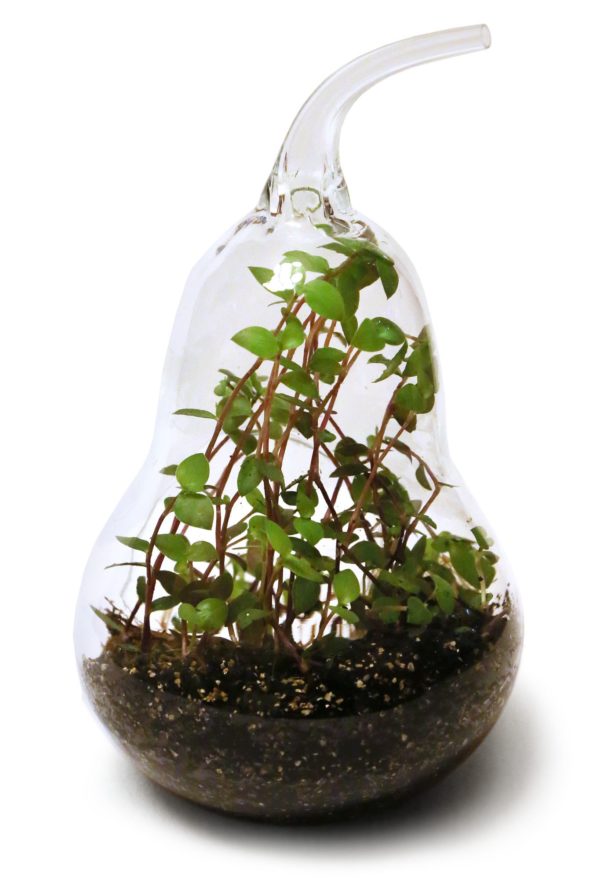

In the 1920s, American scientists in the USA (Harvard University) and Canada began a detailed study of the medicinal properties of plants that were used by the natives of Latin America. Among the 30 thousand studied plants, first of all, attention was paid to callisia, known for its strong wound-healing effect, it was also used to treat joint pains, wounds, ulcers and bruises.
The medicinal properties of this plant have also been studied in Russia. The high efficiency of drugs from callisia in the treatment of wounds, burns, trophic ulcers, frostbite has been established.
However, even with external use of phytoforms of the golden mustache, you must first consult a doctor. With internal use, it is sometimes possible to damage the vocal cords, as a result of which the voice sits down (the damaged ligaments are restored with great difficulty).
There are many biologically active substances in the sap of the plant (mainly in the mustache):
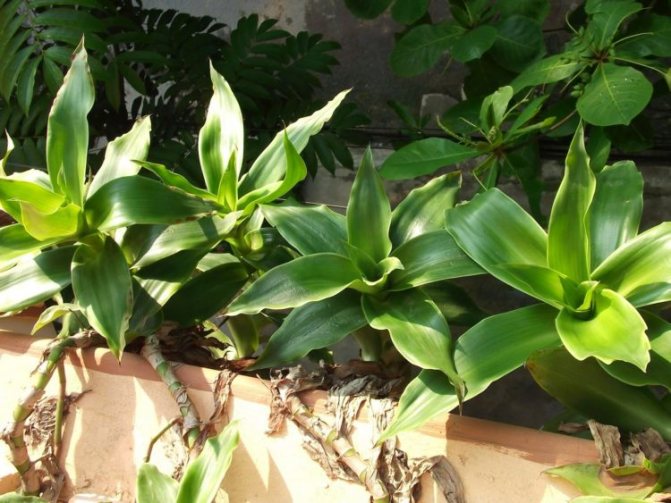

- Quercetin has P-vitamin and antitumor activity, has an antispasmodic, antioxidant and diuretic effect.
- Kaempferol causes a tonic, anti-inflammatory, capillary-strengthening and diuretic effect, promotes the excretion of sodium salts.
- Beta sitosterol determines estrogenic activity
In addition, trace elements are found in the plant - chromium, nickel, iron and copper, which help to improve metabolism at the cell level.
Golden mustache in folk medicine
Callisia is used in folk medicine. Alcoholic tincture is prepared from lateral shoots, divided into greenish-purple internodes (the so-called "joints"). It is believed that a plant acquires medicinal properties when 8-10 internodes appear on the whiskers.
Usually use 30-40 internodes (the concentration may vary depending on the purpose of using the tincture), grind (preferably in a porcelain mortar), pour 1 liter of vodka, insist in a dark place for 10-15 days, shaking occasionally. The tincture becomes dark lilac in color. Store in a cool, dark place.
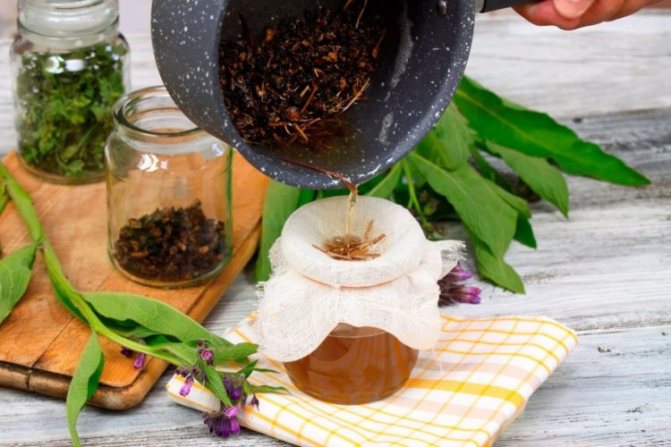

To prepare the infusion use leaves with a length of at least 20 cm. One leaf is placed in a glass or ceramic vessel (it is possible in a thermos) and 1 liter of boiling water is poured, well wrapped, infused for a day, then filtered. The liquid has a raspberry-purple hue.
When making an ointment gruel or juice from the stems and leaves of the plant is added to the fat base. As a basis, you can take baby cream, inner pork or badger fat, petroleum jelly. The juice is mixed with the base in a ratio of 1: 3, gruel - 2: 3. Ointment based on baby cream and petroleum jelly is used for trophic ulcers, skin diseases, wounds, bruises. Preparations based on lard or badger fat are recommended for use in case of disorders of the musculoskeletal system and for rubbing with colds.
The oil is cooked from dried cake after separation of juice from leaves and stems or from gruel obtained by grinding fresh whiskers. The dried cake is poured with olive oil so that the biomass is 1–2 cm covered with oil, insisted for 2–3 weeks, and then squeezed out. The oil extract is stored in a dark glass container in a cool, dark place.
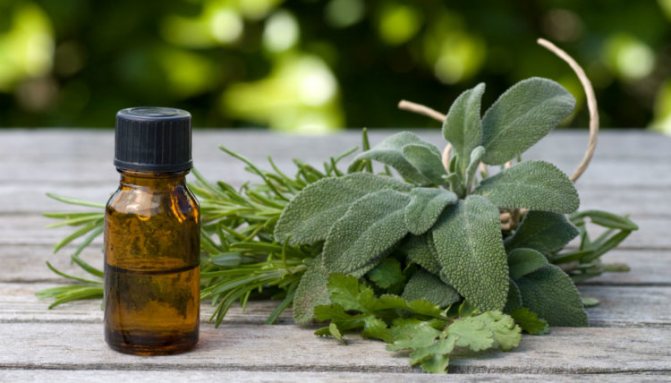

Chopped fresh raw materials can be poured with olive or sunflower oil (1: 2) and simmer in a warm place (temperature 30-40 ° C) for 8-10 hours. The separated oil extract is stored in the refrigerator. The oil is used for massage and applications in the treatment of arthritis, arthrosis and skin diseases.
Plant sap used to treat skin diseases, dermatitis, psoriasis, lichen, trophic ulcers. The fresh sap of the plant is sometimes called "living water". For its preparation, use fresh, just plucked leaves about 20 cm in size.
Diseases and pests of the Golden Mustache (Begonia), treatment
We would like to talk about the medicinal properties of the golden mustache plant, but like any other medicine, golden mustache treatment can be used only after consulting a doctor. The healing properties possessed by callisia are based on phytosterols and flavonoids that are contained in its juice. In addition to these useful substances, the golden mustache plant contains elements useful for human life: copper, nickel, chromium, iron. Most of these elements are contained in the lateral shoots of callisia, they are often used, but the stems and leaves of the callisia plant find their application. They are used to prepare an ointment, an alcoholic tincture, an infusion of a golden mustache, a decoction, and oil. The preparation of a medicine from a golden mustache can be done at home, the main requirement for this is that the regrown lateral shoots have at least 12 knees. For fresh juice, cut leaves and shoots are taken from the callisia plant, crushed in a mortar and squeezed out through cheesecloth. The cake can be used for decoction. To prepare the oil, the cake is dried, crushed and poured with vegetable oil brought to a boil (preferably olive oil); insist for 2-3 weeks, and then filter. Store in a cool, dark place. For the ointment, take a baby cream, animal fat or petroleum jelly mixed with the juice of a golden mustache in a ratio of 1: 3. A tincture from the golden mustache plant is prepared using 12-15 knees and 0.5 vodka. Pour in a glass container and leave for 2 weeks, strain and store in a cool place. To prepare an infusion, a leaf at least 20 cm long is crushed and poured into a thermos with a liter of boiling water. Withstand 6-7 hours, then filter and store as a tincture. The broth is prepared from 15-20 knees in an enamel or stainless container, brought to a boil, and then left under a lid for 8-10 hours, then filtered and stored in the refrigerator. What does a golden whisker heal? as an effective remedy for combating warts, as a wound healing, antiseptic, fresh juice is used. Gruel or ointment from fresh leaves is applied to sore joints and boils in the treatment of arthritis. In cases of treating fungal skin diseases, alcohol tincture is used, it is applied 2 times a day to the affected areas. In the treatment of sciatica, an ointment or alcohol tincture of a golden mustache is used. The ointment on a layer of gauze is bandaged to the sore spot for 30 minutes, then the remnants of the ointment are removed with a cotton swab. With hypotension and hypertension, with diseases of the kidneys and liver, respiratory organs, in the treatment of the gastrointestinal tract, with anemia, headaches, as well as in gynecology, preparations from the golden mustache are taken orally.
Hit this season! Wonderful buttock Fabulous gathering A unique set for growing strawberries with your own hands right on the windowsill. The technology used makes it possible to produce a natural and very tasty product without losing the beneficial properties inherent in fruits grown in the summer in the open field.
Callisia (Latin Callisia)
- a genus of evergreen herbaceous perennials of the Kommelinovye family, growing in the humid penumbra of the tropics and subtropics of the Antilles, as well as the countries of Central and South America. There are 12 species in the genus, and some of them are grown in indoor culture. The name of the plant comes from two Greek words that translate as "beautiful" and "lily", although the closest relative of callisia is not lily, but Tradescantia.
Growing difficulties
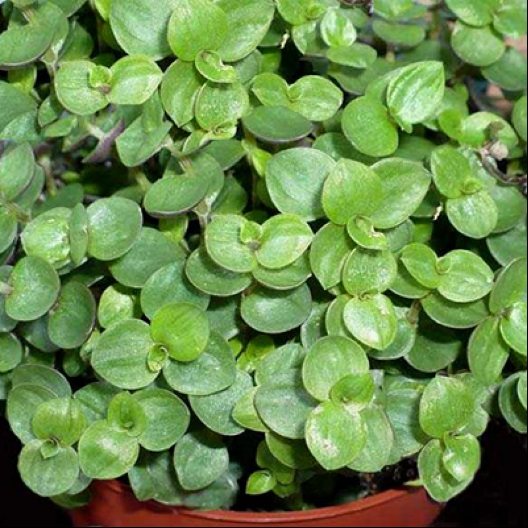

Callisia
Basically, spider mites and thrips like to settle on a flower. For protection, it is better to use biological products.
Traditional healers use callisia as a medicinal plant. Its juice is said to contain highly active beta-sitosterol compounds that may help fight disease:
- the prostate gland;
- metabolism;
- vessels;
- endocrine system.
Callisia deserve the attention of flower growers due to their unpretentiousness.
Planting and caring for callisia (in short)
- Bloom:
in indoor culture it blooms infrequently, usually in late summer or early autumn. - Lighting:
bright diffused light or partial shade. - Temperature:
during the period of active growth - 20-24 ºC, in autumn and winter - 16-18 ºC. The lower temperature limit is 14 ºC. - Watering:
during the growing season - as the upper layer of the substrate dries up. In winter, between waterings, the substrate should dry out to a third of the depth. - Air humidity:
increased. In the heat, it is recommended to regularly spray the leaves from a fine spray. - Top dressing:
from April to October - 2 times a month with a solution of complex mineral fertilizer. In the rest of the year, you can not apply fertilizer. - Rest period:
from November to March. - Transfer:
young plants - annually, adults - once every 2-3 years. - Reproduction:
apical cuttings, layering, dividing the rhizome. - Diseases:
loss of decorativeness as a result of poor care or violation of conditions of detention. - Pests:
thrips and spider mites. - Properties:
the plant does not tolerate tobacco smoke.
Read more about the cultivation of callisia below.
Reproduction
Callisia is propagated:
- apical cuttings;
- layering.
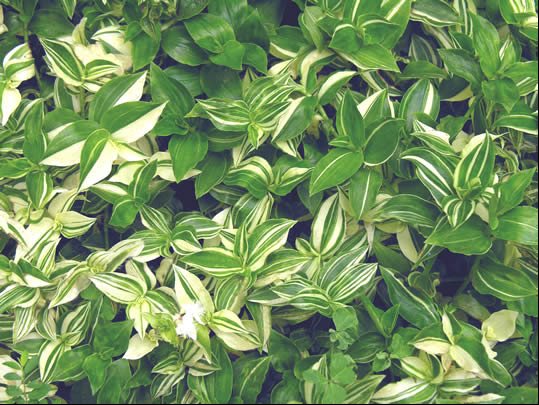

Callisia
Cuttings are cut in spring and then put into water. After the roots appear, the plant is transplanted into the ground. For greater attractiveness of the future composition, several cuttings are planted in one pot.
Layers are dropped directly into the ground near the plant. After the roots appear, they are cut off and planted in a separate container.
Callisia care at home
How to care for callis at home
Callisia flower needs to be kept under bright, diffused light, but shaded from direct sunlight. In a well-lit room, callisia can be placed even away from the window. Indoor plant callisia - a flower not for the kitchen: it does not tolerate tobacco smoke,
fumes, impurities and needs a constant supply of fresh air, so home callisia likes to spend summer on the balcony or in the garden. This plant can be grown not only in residential premises, but also in offices, organizing ventilation without drafts, which harm the flower even more than stale air.
In the photo: Callisia in nature
The usual room temperature is quite suitable for Callisia: in the summer 20-24 ˚C, in the winter - 16-20 ˚C. However, callisia should be protected from sudden changes and low temperatures: the lower limit for a plant in winter is +14 ˚C.
Watering and feeding callisia
During the period of active growth, that is, from spring to autumn, callisia is watered with soft water at room temperature, as soon as the top layer of soil in the pot dries. In winter, watering is reduced, especially if the dormant period of callisia is cool.
However, the complete drying of the substrate in the pot cannot be allowed: the plant may die. When watering, water should not fall into the center of the outlet: this can cause the formation of rot.
The tropical flower callisia requires high air humidity, especially in the summer heat and in winter, when heating devices are operating at full capacity in the apartment. To prevent the plant from suffering from dry air, it will often have to be sprayed from a fine spray or use a household humidifier.
From April to October, callisia is fed 2 times a month with a solution of complex mineral fertilizer, the rest of the time the plant does not need feeding.
Callisia transplant
Young callis is transplanted annually, adult - once every 2-3 years. The plant is transferred into a pot filled with expanded clay or pebbles by one quarter of its volume, which should be 2 cm larger than the old dishes in diameter, and the remaining space is filled with a mixture of equal parts of turf, humus, sand and leafy earth. After transplantation, callisia is watered.
In the photo: Callisia at home
Some growers believe that it is pointless to transplant callisia; it is better to grow a new plant from cuttings. If your callisia in the lower part of the stems is very bare, then it is probably better to actually carry out cuttings instead of transplanting. However, with good care, the plant grows old and does not grow very quickly.
Reproduction of callisia
Callisia is propagated throughout the year in the same ways as Tradescantia, ivy or hoya. For example, they cut off an apical stalk with 3-4 internodes, lower it into water with a cut and wait for the roots to grow back. Rooted cuttings are planted in several pieces in a pot with a substrate. It is easy to propagate callisia also by layering:
the shoot is added dropwise at the level of the second or third node, right in the pot with the plant, if space permits, or another pot with the substrate is placed next to it and the cuttings are added in it. As soon as the shoot takes root, it is separated from the mother plant.
When transplanting, you can divide the callis into parts and plant them in different pots.
Transplant and substrate
It is better not to transplant callisia, but to constantly receive new plants from the apical shoots.
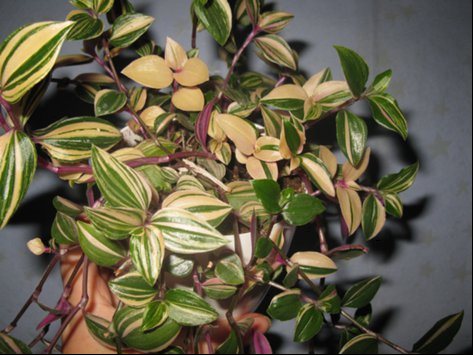

Callisia
The soil for planting must be loose and permeable. To make up the potting mix, the following ingredients are required in equal parts:
- sod land;
- leafy land;
- humus;
- sand;
- peat.
It is better to put broken brick, expanded clay at the bottom of the flower pot.
Callisia pests and diseases
Callisia diseases and their treatment
Callisia is almost not affected by infections, but if the plant suddenly starts to hurt, then this is exclusively your fault: apparently, you did not create the necessary conditions for it or did not take good care of it.
- For example, if the tips of the leaves of callisia begin to dry, this means that the plant is experiencing a chronic lack of moisture and suffers from dry air.
- Poor lighting leads to stretching of shoots and loss of callisia leaves.
- Stagnant water in the roots due to poor drainage or too much watering can result in leaf fall and root rot.
Read again the chapter on the conditions of keeping callisia and recommendations for caring for the plant, and then correct the errors found.
Callisia pests and fight against them
Of the pests, callisia can be attacked by thrips and spider mites. Both of these pests feed on plant sap through bites in the leaves, which is why they turn yellow and fall off, and the plant gradually withers. Thrips
can be destroyed with insecticidal preparations, and
ticks
- acaricidal. It is advisable to carry out treatments outdoors, since these drugs are toxic to humans and pets.
The chemical composition of fragrant callis
The rich composition of chemicals and compounds and their excellent ratio have put the plant in a number of unique natural remedies that give health and beauty to people.
What is included in homemade ginseng:
- Flavonoids.
They belong to antimicrobial, expectorant, vasodilating agents, help to normalize the work of the heart muscle, and have antihistamine properties.
- Pectins.
They are a natural absorbent capable of binding and removing toxins, heavy metals, radionuclides from the body, and have a beneficial effect on the intestines.
- Phytosterols.
Produce and synthesize hormones. They help to reduce blood cholesterol levels, are considered natural antiseptics for the body, immunostimulants.
- Vitamins.
Vitamins A, C, B, amino acids, iron, zinc, potassium and calcium. There are biogenic stimulants (metals in combination with organic substances) that can enhance the effect of nutrients entering the body.
- Tannins.
They are very useful for the gastrointestinal tract, help in the treatment of inflammation of the mucous membranes of all organs.
Types and varieties of callisia
Or callisia graceful
- a miniature plant with geniculate creeping stems more than half a meter long, which first grow straight and then descend. This plant is very similar to Tradescantia. It reaches a height of 30-40 cm. Both the leaves and stems of the graceful callisia are covered with velvety pubescence. Oval, pointed at the ends, petiolate, up to 6 cm long, the leaf plates of the plant are painted in a violet-green hue on the lower side, and dark green with silvery stripes on the upper side. This species blooms with white flowers that form at the ends of the shoots. The plant does not live very long: after two years, the leaves, which lose their brightness in color, no longer cover the shoot so tightly, therefore, flower growers restore the vine by cuttings or layering.
In the photo: Callisia elegans
A changeable plant, the decorativeness of which depends on the variety and conditions of detention. It is a succulent with creeping stems that quickly take root at the nodes and juicy, lanceolate, strongly concave two-row leaves with a longitudinal groove, painted on the upper side in a bronze-green shade of red in the sun, and brownish-purple on the bottom. The leaves are bare, but along a line ascending from the sinus, fringed with small hairs, reaching a length of 2, and a width of 1.5 cm.
In the photo: Callisia navicularis
Callisia creeping (Callisia repens)
The plant is up to 20 cm high and up to 30 cm wide with thin reddish or purple stems and small heart-shaped bright green leaves in purple specks arranged in two rows on them. The flowers of this species are white and inconspicuous. At home, callisia repens is grown in suspended structures, and in the garden it is used as a ground cover plant. Such garden forms of the species are known:
- Bianca
- Callisia with red-violet delicate stems and small bright green leaves; - Pink Panther
- variety with striped pink-green leaves.
The varieties of Callisia creeping Pink Lady, Noum Popula and Tortl are also popular.
Origin. USA, Argentina.
Description
... Callisia flower is a very decorative cascading, low-growing herbaceous perennial plant with many small green, fleshy leaves on creeping stems. Over time, the plant forms dense clusters. In some species, the lower part of the leaf blades is colored purple, and in the fall and winter, the leaves turn dark purple. The flowers are white, sometimes fragrant. Grown for attractive foliage, flowers are inconspicuous. There are varieties with striped leaves.
Varieties:
Golden mustache or fragrant callisia - Callisia fragrans
Golden mustache does not look as attractive as ornamental species, but it is a valuable medicinal plant and is able to purify the indoor air from harmful substances. Creeping perennial herbaceous evergreen plant with oblong-elliptical, pointed leaves up to 25 cm long and up to 5 cm wide. Drooping stems grow up to 90 cm in length. The leaves are glossy green, in good light they acquire a reddish-purple hue. The flowers are white, fragrant, with three oblong petals, short-lived.
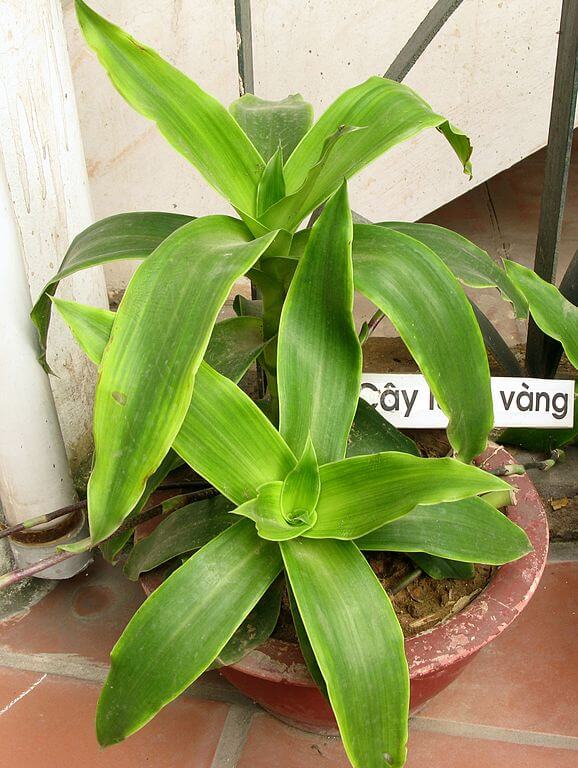

Callisia navicular or tradescantia navicular - Callisia navicularis
Miniature perennial evergreen succulent with profusely branching, fancifully curved stems. Due to its leaves, it has an extremely unusual appearance - the leaves are pink, burgundy or green, depending on the lighting and the type of plant, heart-shaped, sessile, coming out of the stems alternately, opposite each other. The flowers are small but attractive, pink, with 3 rounded petals and long yellow stamens.
Height
... It grows quickly and can reach a height of 10 cm.The drooping stems of the plant grow up to 40 - 90 cm.
Types of callisia with photos and descriptions
The genus has 20 species of magnificent plants, some of them are used in home floriculture.
Callisia graceful Callisia elegans
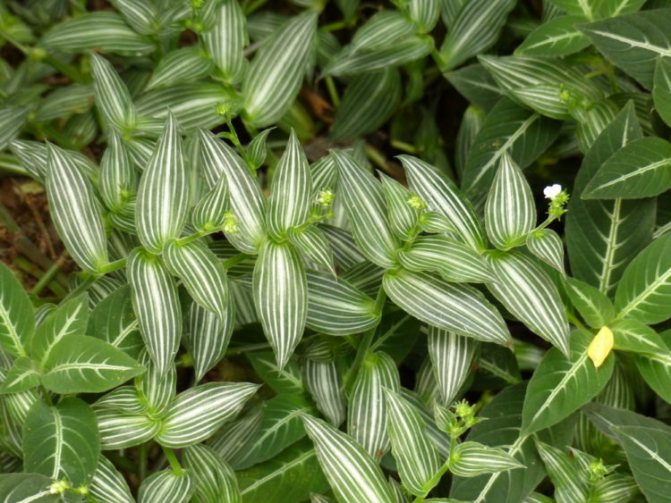

The most popular and the first among the cultivated species. The bush is lush, juicy stems are densely covered with spear-shaped leaf plates. On the dark green background of the upper part of the leaf, silvery stripes are scattered, the reverse side is purple.
Callisia navicular Callisia navicularis
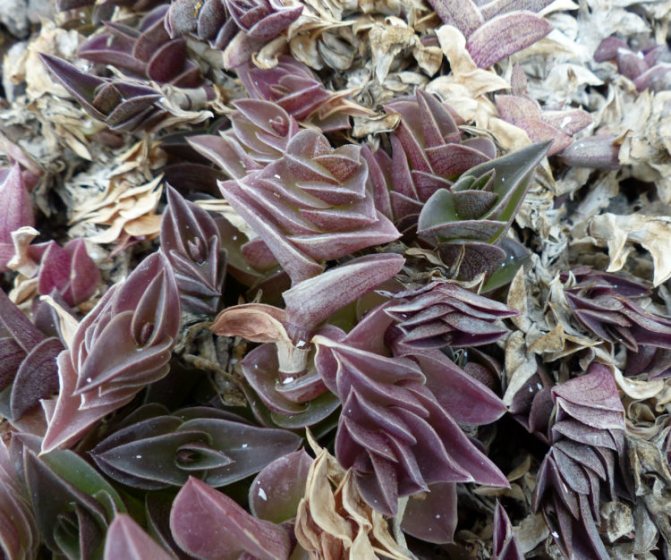

The shape of the leaves (boat or boat) prompted the name of the species. The leaf plates are fleshy, green in color with a grayish tinge, as if poured out of wax. On the reverse side, the leaves are strewn with purple specks - a kind of protection from intense sunlight. Flowers are pink or lilac.
Callisia creeping Callisia repens
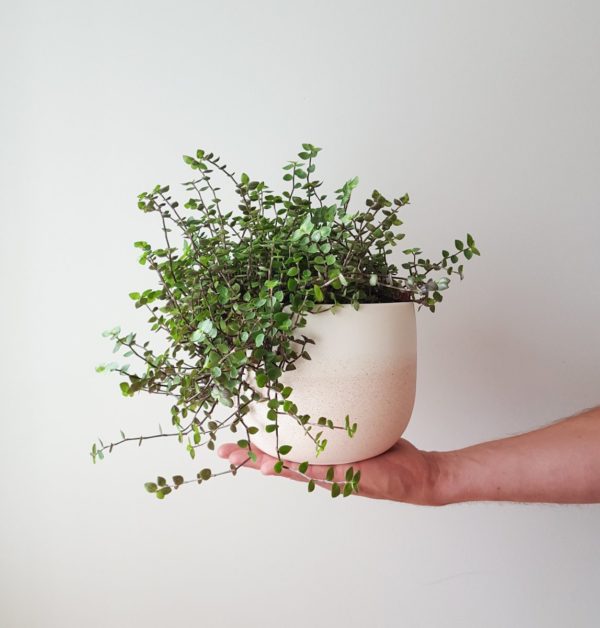

Fleshy leaves of bright green color are planted in pairs on numerous shoots. Varieties with purple stems are common and can take root at each node. Leaves are oval, 1-4 cm long, 1-2 cm wide, sharp at the apex, rounded at the base, sessile, succulent, glabrous, with the exception of pubescent species.
Callisia fragrant Callisia fragrans or the legendary Golden mustache
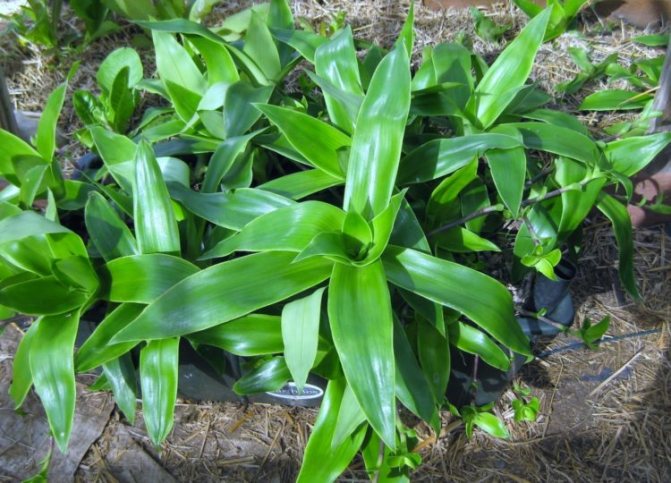

Outwardly it resembles an indoor lily. The leaf plates are long, deep green in color, and can turn pink and scent when rubbed. From the main shoot, geniculate shoots or whiskers depart, at the ends of which a new plant is formed (they can be rooted). The flowers are snow-white.
The medicinal properties of fragrant callis are questionable and have not been confirmed by official research. The flavonoids kaempferol and quercetin were found in the juice. In folk medicine, it is used to treat ulcers, diseases of the intestines, endocrine system, atherosclerosis, metabolic disorders, and wound healing. You should not engage in treatment without the agreement of your doctor. Esotericists recommend placing a plant at the head of the bedroom to get rid of nightmares.
Keep in mind that callisia can cause an allergic reaction in our smaller brothers (especially cats and dogs), which manifests itself in reddening of the skin and itching. In this regard, the last two described types of callisia are safer.
Callisia care
Temperature conditions
... Moderately warm content. A temperature of about 18 ° C is considered ideal. When kept in warmer conditions, it is necessary to increase the frequency of watering and the humidity of the air. In winter, when the plant is resting, it should be placed in a cooler place with a temperature of 10-15 ° C.
Lighting
... Well-lit location with no direct sunlight during the day. The sun can hit the plant only in the morning and evening hours. In partial shade, the leaves lose their attractive color.
Callisia at home
... Pinch the tips of young shoots regularly to keep the plant compact. If pruning is not carried out, the plant will look untidy. Remove too green leaves in time, which also spoil the appearance of the plant.
Substrate
... Well-drained and nutritious peat-based soil with the addition of coarse sand and perlite.
Top dressing
... Every two weeks, during the period of active growth, they are fed with standard liquid fertilizers. During the rest period, feeding is stopped.
Appointment
... Good for hanging baskets with long stems hanging over the edge of the pot.
Flowering time.
Flowers, as a rule, are inconspicuous, appear in the summer.
Air humidity
... It is worth remembering that the higher the temperature of the content, the higher the humidity should be. Place the plant pot on a tray of damp gravel, use a room humidifier, or spray the foliage regularly with room temperature soft water.
Soil moisture
... Watering is abundant, however, the topsoil should be slightly dried before the next watering. Always remove excess water from the sump. During the rest period, the frequency of watering is reduced.
Transfer
... Depending on the type, the frequency of transplantation for callisia is different. Plants with striped leaves often do not need to be transplanted at all, since after the age of 2 years, the plants lose their attractiveness and must be replaced with new ones. The fast growing species are transplanted each year in the spring into larger pots.
Reproduction
... Callisia is a close relative of Tradescantia and also propagates by cuttings taken in the spring. Cut the cuttings 5 to 10 cm long and remove the lower leaves from them. Root in a damp mixture of peat and sand, or in a simple glass of water. Powdered growth hormones can be used for rooting. Cover young plants with a clear plastic hood or glass to maintain moisture and place in a warm place in partial shade. Rooting takes 2 - 3 weeks.
Pests and diseases
... The tips of the leaves turn brown and dry out with insufficient air humidity. Decay when waterlogged and stagnant water, especially in the autumn-winter period. The most common pests are aphids and red spider mites.
Note
... With age, the stems of callisia are often bare in the lower part and this plant is changed to a new one. Some types of callisia cause allergic reactions in pets.
Hydroponics
.
You may also be interested in:
Callisia is a genus of perennial evergreen herbaceous plants of the Kommelin family. Most representatives of the genus are characterized by creeping stems. Natural habitats - humid shady places of tropical and subtropical forests of Central and South America, where the plant forms dense sod.
As ornamental indoor plants, Callisia gentlei and Callisia repens are grown. But especially popular Callisia fragrans or "Golden mustache", it is grown as a medicinal plant.
Callisia elegant
- perennial herb with creeping stems, resembling tredescantia. The leaves are arranged on the shoot alternately in 2 rows, oval in shape, pointed at the ends. The leaves are velvety, dark green in color with narrow longitudinal silvery-white stripes along the veins, purple-green on the back. Stems and leaves are covered with slightly pubescent. The flowers are small, white, located at the tops of the shoots.
Callisia creeping
- herbaceous plant, with miniature leaves 0.5-2 cm long, about 10 cm high. Creeping stems, thin, leaves are arranged in 2 rows, close to each other. The leaves are green with barely noticeable purple specks, on the back - with a burgundy tint. The plant grows very quickly and becomes like a green carpet.
Callisia fragrant
(Callisia fragrans) reaches 70-120 cm in height, its shoots are thick. Fleshy, there are two types: erect vertical with large elongated leaves, reminiscent of corn, and horizontal, creeping, with underdeveloped leaves, forming a leaf rosette at the ends. The flowers are graceful, white, small. It rarely blooms at home. This species is known for its medicinal properties, for which it is called "homemade ginseng".
How the plant is propagated
Callisia propagates by young shoots, cut off only when the number of joints reaches 8-10 pieces. The shoots can be placed in a container of water, you can use wet sand. When the roots appear, the young plant is planted in the ground. The best breeding season is from March to April. During the first year, the formation of a plant occurs, then shoots appear.For medicinal purposes, shoots should be chosen that have a purple tint, with 10-12 joints. The maximum accumulation of useful properties is observed in the fall.
Medicinal properties of the "Golden Mustache"
Fragrant Callisia juice contains quercetin and kaempferol. Quarcetin has anti-inflammatory and antioxidant properties, slows down oxidative processes in the body, it is recommended to take it in the treatment of inflammatory processes, including arthrosis and arthritis. Camferol - has tonic and anti-inflammatory properties, strengthens capillaries and removes excess fluid from the body. These substances, possessing similar properties, enhance the action of each other.
Tincture of Golden Mustache is an excellent anti-inflammatory and tonic. External application of fragrant callis has a good effect in the healing of wounds and trophic ulcers.
Traditional healers use this plant to treat endocrine diseases, to strengthen blood vessels and the heart, to treat kidneys and liver, as well as as part of a comprehensive treatment of diseases of the gastrointestinal tract. But it is also known that unreasonable ingestion of the juice and infusion of the golden mustache can cause poisoning and severe allergic manifestations.
At home, the golden mustache plant is usually used to treat inflammatory diseases of the skin and joints. For therapeutic purposes, you can take leaves (mashed so that juice appears) and apply to wounds, abrasions, calluses, boils. Tincture on alcohol or vodka of pieces of horizontal shoots is used for rubbing with inflammatory diseases of the joints.
A golden mustache is considered an adult, and therefore medicinal, when a rosette with leaves appears at the end of the mustache, suitable for separation and further rooting. Most often, a young plant is cut off, rooted in a new pot. The shoot itself is divided into parts and used for treatment immediately or placed in glassware, poured with alcohol or vodka, tightly closed and placed in a dark place.
Important
! It is possible to grow fragrant callis (Golden mustache) for medicinal purposes only in a clean, regularly ventilated room or in the fresh air. Kitchen fumes, tobacco smoke and other harmful substances are intensively absorbed by the leaves of the plant. This is useful for purifying the atmosphere at home, but not good for healing.
Callisia is grown as an ampel or ground cover plant, it is best to plant it in a hanging basket or in a tall pot. Caring for all popular indoor varieties is about the same, it is not particularly difficult.
Lighting
... Callisia loves light, but it is desirable that it be diffused. In good light, the leaves are bright and rich in color.
Temperature
... Heat-loving plant, does not like sudden changes in temperature. It is better to keep it at 15-20 ° C in winter and -20-25 ° C in summer. In warm weather, it is useful to take it out to the balcony or terrace, but pick it up before the nights get cold.
The soil
... Fertile loose soil with neutral acidity is most suitable.You can prepare a mixture of sod and deciduous soil with the addition of humus, peat and sand (taken in equal quantities).
Watering
... A moisture-loving plant, but if you forget to water, then nothing special will happen to it. In summer, callisia is watered abundantly, with lukewarm settled water, in winter, watering is moderate. Regular spraying is helpful.
Fertilizer
... Callisia is fed from April to September with a complex mineral fertilizer, once or twice a month. Before using for treatment, the golden mustache is not fed or watered with a weak organic fertilizer.
Transfer
... All callis grows quickly, so only young plants are transplanted if necessary. An adult plant is usually not transplanted, but new cuttings or daughter outlets are simply rooted. The cuttings are fully rooted in 2-3 weeks.In callisia creeping, to obtain a lush bush, as soon as growth begins, it is recommended to pinch the top to stimulate the appearance of lateral shoots.
Reproduction
... Propagated by cuttings, fragrant callis - also by daughter rosettes. The cuttings are usually rooted in plain water and planted in the substrate only after the root system has fully developed. In open ground or in a wide pot, creeping shoots easily sprout when in contact with wet soil.
Callisia
- a perennial herb of the Kommlinovye family. Callisia is native to Central and South America.
Of the 12 plant species included in the Kallisia genus, only 5 are grown at home:
- Elegant;
- Tehuantepec;
- Scaphoid;
- Creeping;
- Fragrant.
Indoor views
Callisia elegant (graceful)
- a plant reaching 30-40 cm in height, creeping shoots. The leaves are dark green, with silvery-white stripes on the upper side, and below - with a purple tint. They have an oval shape, pointed at the ends. Pubescent stems and leaves. It blooms with white flowers that are located at the tips of the shoots.
Callisia tehuantepec
bears a resemblance to elegant, but there are no silvery-white stripes on its leaves. Its flowers are bright pink.
Callisia scaphoid
- a plant with succulent leaves on short stems, green above and brown-purple below. The shape of the leaves resembles a boat, they reach 2 cm in length and 1.5 cm in width. When the plant is grown in bright sun, the leaves turn reddish.
Callisia creeping
- the plant, reaching a height of 10 cm, grows very quickly. Stems are thin, creeping, with small green leaves, up to 2 cm long. On the upper side of the leaves, purple specks are barely noticeable; on the lower side, the leaves have a burgundy hue.
Callisia fragrant or "golden mustache"
... In indoor conditions, the plant reaches a height of 1-1.5 m. It has 2 types of shoots: erect and horizontal. In the former, the leaves are normally developed, reaching 20-30 cm in length, 5-6 cm in width. The latter are curly processes (whiskers), consisting of joints with leaf panicles (underdeveloped leaves) at the end. Flowering occurs at the end of winter, in indoor conditions this is rare. Flowers are small, inconspicuous.
It is widely used in folk medicine for the treatment of various diseases. Its horizontal shoots, which have reached a sufficient degree of maturity (when the internodes acquire a purple hue), act as a medicinal raw material.
Care
Callisia grows well in bright diffused light, the scaphoid can also tolerate direct rays of the sun. For normal development, you need to provide 8-10 hour daylight hours, with a lack of lighting, the leaves become pale, the distance between them increases, as the shoots are stretched.
Does not tolerate temperature changes. In summer, it needs to be provided about 20-25 ° С, and in winter within 15-20 ° С.
Watered with soft, settled water, abundantly in summer, moderately in winter. It is undesirable to allow the earthen coma to dry out. Frequent spraying is required. The elegant one must be sprayed with a small sprayer, since the leaves have pubescence.
In the warm season, the plant must be fed with mineral fertilizers ("Uniflor-growth") at intervals of 1 time in 10 days.
Pests
At air humidity below 60%, and may be affected. To combat them, you need to use washing the leaves with water, soapy water. If there is a lot, then it is better to apply (agravertine, vermitic, inta-vir).
Diseases
The plant ages quickly enough, the lower part of the stem is bare, so it is necessary to cut the shoots once every 2-3 years for rejuvenation or pinch them annually.
With insufficient moisture, the tips of the leaves become dry. Timely watering and spraying of the plant is necessary.
With excessive watering and stagnant water in the pot, the stems and roots can rot. If this happens, then it is necessary to remove the decayed parts of the plant, and the surviving ones should be transplanted into new soil. In this case, all sections must be processed with crushed coal.
Reproduction
Callisia is mainly propagated by apical cuttings. Cuttings, consisting of 2 joints, are rooted in water or light nutrient soil under a glass cover. Roots appear quickly, after 7-10 days.
Callisia can also be propagated by rooting long horizontal shoots. When these shoots touch the ground, roots begin to develop. To make the rooting process faster, part of the shoot can be sprinkled with earth. After rooting, the shoots can be cut off from the mother plant and transplanted to a permanent location.
The soil for planting should consist of turf and leafy soil, humus, peat and sand (in equal amounts). Good drainage must be ensured.
Content
Callisia is a tropical plant, but grows well at home. To create optimal conditions, you must:
- maintain the ambient temperature within 18 - 25 degrees;
- periodically spray the flower from a spray bottle.
When containing callisia, it is necessary to take into account their features:
- the color of the leaves depends on the intensity of sunlight;
- does not like sudden changes in temperature;
- overdrying an earthen coma leads to the death of the plant;
- old shoots are quickly exposed.
The healing properties of callisia
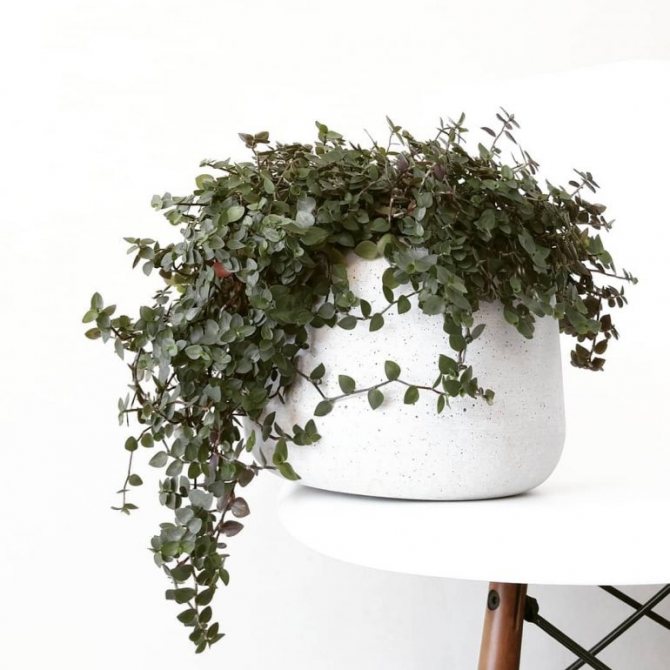

The leaves of the plant are capable of releasing beneficial phytoncides into the atmosphere, so it is recommended to move the planting to the head of the bed at night. It will help get rid of insomnia and nightmares. The juice of the Golden Mustache is useful and used in folk medicine:
- promotes wound healing;
- treats skin diseases;
- eliminates lichen, ulcers, eczema;
- helps to get rid of ulcers and bowel problems.
The sinewy part of the plantation can be chewed before going to bed - swallow the juice and discard the pulp.
Benefit and harm
Callisia creeping, like its other varieties, has a positive effect on the body. Its juice is rich in minerals and vitamins. Beta-sitosterol in the composition of callisia helps with atherosclerosis, thyroid diseases, metabolic disorders and other diseases. From the practice of traditional healers, it is known that the medicinal properties of callisia are similar to ginseng and rhodiola, although this has not been proven by science. When a disease occurs, each person decides for himself whether to be treated in the traditional way or in the folk way. But what is definitely proven is the cleansing effect of the plant.
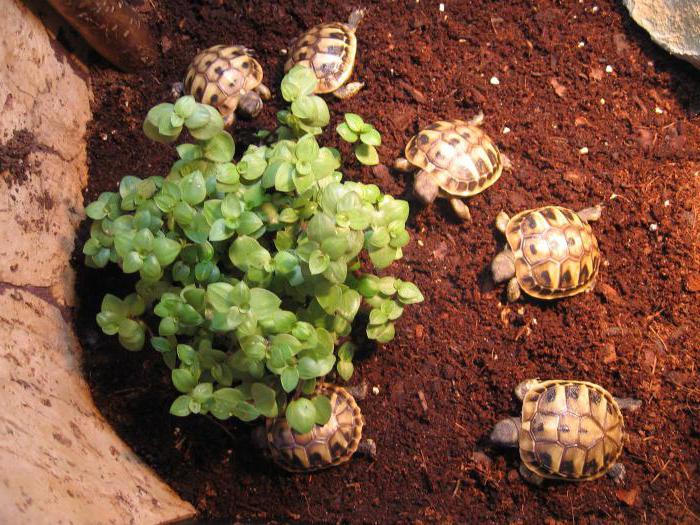

By planting a flower, the landlords receive a free and very beautiful air purifier. The energy of creeping callis has a positive effect on the home atmosphere. With this plant, peace and understanding reign in the house. The antiseptic properties of flower phytoncides have a beneficial effect on humans. Therefore, it is recommended to put it in the children's bedroom. Callisia bloom is the first sign that the energy in the room is positive and there are no problems in the house.
Conditions for growing callisia
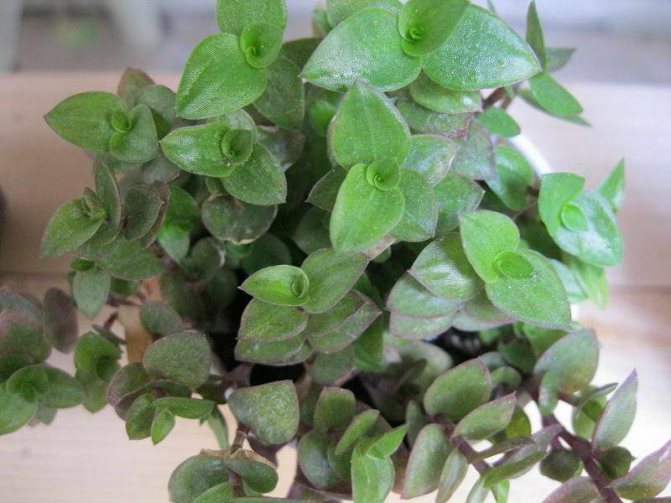

Callisia creeping flower description care photo
Illumination
Direct sunlight can harm the plant: brownish rounded spots will appear on the surface of the leaves. If the lighting is insufficient, the variegated leaves will lose their color. The best solution is to grow it on an eastern or western windowsill during the warm season, from late autumn and throughout the winter keep it on the southern windowsill. Callisia perfectly tolerates light shadow, so you can place the beauty in the back of a bright room. In strong shade, the shoots stretch out, the distance between the pairs of leaves increases noticeably.
Airing
The plant is ideal for spacious rooms that are regularly ventilated.In the kitchen, as well as in places of smoking, it is not worth placing callisia. It is useful for her to spend the warm season in the fresh air - take it to the loggia, garden, but do not forget about shading from the bright sun.
Air temperature
Callisia loves warmth and develops comfortably at moderate temperatures. So, during the spring-summer season, it is desirable to maintain the air temperature within 20-25 ° C.
In winter, keep cool (16-18 ° C), but the thermometer should not drop below 14 ° C. With hypothermia, the leaves will become soft, translucent. It is necessary to return the plant to warmth. Callisia will grow quickly without a cool wintering (the shoots will elongate and thin out). The temperature drop should not be abrupt, and also protect from drafts.
Diseases
It should be borne in mind that callisia is prone to rapid aging. The lower stems are bare. It is very important to prune the shoots every year to rejuvenate the plant. The extreme part of the foliage with an insufficient level of moisture becomes excessively dry. You can help the culture by regular spraying and timely watering.
An excess of water leads to stagnation of fluid, as a result of which the root system rots. With such problems, experienced florists recommend removing the decayed part without regret, and replanting the part that has survived into new soil. Each cut should be treated with crushed charcoal.
Botanical description
The name of the genus comes from the Greek word. κάλλος, which translates to "beauty". Indeed, this delicate plant surprises not with the beauty of flowering, but with the attractive appearance of its foliage.
Perennial is a slowly growing plant, the height of which reaches 100 cm, and the width is 65-120 cm. The foliage of callisia is quite large (15-25 cm). During the growth period, convex areas appear on the stem, which are subsequently transformed into antennae (separate shoots). Leaf rosettes are located at the tips of the shoots.
Antennae of the first type can be used for reproduction from the moment they acquire a lilac color. Shoots of the second type resemble straight, fleshy foliage. All bases of such shoots are placed close to each other, so inexperienced growers often consider them one large rosette. When tearing the foliage, you can see fine hairs that stretch well.
Types of callisia and their photos
Callisia the graceful
(Callisia elegans)
- a perennial herb with creeping stems. Leaves are ovate with a pointed tip 2 cm long, 0.5-1 cm wide. Above they are velvety, dark green with narrow longitudinal silvery-white stripes along the veins, purple below. Callisia flowers are small, white at the tops of the shoots.
Callisia creeping
(Callisia repens) about 10 cm high, its stems are creeping, creeping, densely leafy. Leaves with a tubular sheath, tightly covering the stem, cordate, pointed at the end, about 10-15 mm long. As you can see in the photo of callisia, the surface of the leaf of this species is green, the reverse side has a burgundy tint.
Care features
In order for a flower growing in an apartment or office to be healthy and pleasing with its appearance, you need to take care of it: water, feed, loosen the soil, remove damaged stems and dry leaves. The plant is unpretentious for watering, but the soil should not be allowed to dry out, as this will negatively affect growth and development. The earth must be constantly moist. It is important not to allow waterlogging, otherwise rotting of the stems and roots will begin. Callisia creeping in care is unpretentious, however, it needs regular watering in the summer, in other periods this should be done as needed. In winter, watering is reduced. It is required to constantly monitor the ground surface. If it is dry, water it, if it is wet, do not moisten it. If watering is carried out rarely, the plant withers, the shoots dry out.
Read also How to propagate gardenia jasmine
The flower is regularly fed with a complex fertilizer for flowers. This should be done monthly, excluding winter. At this time, feeding stops. More frequent feeding is undesirable, as the plant will grow violently, the stems will weaken.
Where is the best place to place the flower?
If the cultivation of creeping callis is carried out in a bright room, it is not necessary to put it on the windowsill. You can define a place for a flower in the back of the room, where there is no direct sunlight hitting the plant. Due to this feature, callisia is often bred for office space.
For the best growth and development of the flower, spacious living or office spaces, equipped with ventilation, are best suited, due to which the flow of fresh air is provided. If the room is not ventilated, it is always stuffy, smoky, the flower will not grow, it will die. In summer, it is best to take the plant pot outside.


Growing and transplanting
When growing callisia at home, it is difficult to achieve its flowering. This happens in the first weeks of summer. Small white flowers. They are formed in the upper part of the shoots and have a rather pleasant smell.
If you prefer hanging-type balls made of ampelous plants, then for their placement you need to choose shaded areas of the house. It is necessary to make a wire frame with large cells and a hook for fixing it in a suspended state.
So that the soil does not fall out of the frame, moistened sphagnum is placed inside it. Additionally, you can strengthen the walls using a nylon with holes for cuttings or a fabric-type mesh. Then a moist soil mixture is placed inside. Cuttings of the plant are planted on all sides of the sphagnum.
The resulting ball must be sprayed with water. The first days it should be kept wrapped in polyethylene in the light. Then the film must be removed and the plant must be left in low light for 1 day, remembering to spray it.
With weak rooting, you can add more planting material. The substrate must be watered regularly, and the plant itself must be turned towards the light in different directions.
The plant must be regularly rejuvenated using apical cuttings. They must be planted in a pot with nutrient soil. The shoot will be ready if more than 12 “joints” have appeared on the shoot.
Description and features of the plant
Callisia is distinguished by creeping stems. Sometimes you can find plants with erect stems. Their homeland is the subtropical and tropical parts of America. Here they grow in wet areas.
The most suitable place for growth is a warm, fairly bright room with a constant supply of fresh air.
It is not recommended to leave collision in rooms saturated with different smells. In the spring-autumn period, the pots can be taken out on the veranda or balcony. It is better to plant it in wide vases; it is permissible to create compositions with other plants.
If you have animals in your house, then you need to purchase this plant with caution. Indeed, many species, for example, fragrant callis, as well as creeping, can cause allergies in them, manifested in a discoloration of the skin and itching.
The difficulties of cultivating the culture of callisia
Callisia is practically not susceptible to disease. If any ailment arises, you should know - you yourself had a hand in this, because this is always connected with a violation of caring for the plant and providing it with proper conditions of detention. As for insect pests, then no one is to blame. Callisia can fall prey to spider mites and thrips.
There are other problems as well:
- Decay of the plant, browning of vegetative organs, leaf fall. The reason is the flooding of the soil under the flower, excessive moisture in the soil.
- Drying of the tips of the leaves. The reason is a lack of moisture in the soil, a low level of air humidity.
Finally, let's return to the famous type of callisia - fragrant Callisia or Golden Mustache. This plant is known to have medicinal properties. It enriches the room air with bactericidal compounds - phytoncides. Exotic juice perfectly heals a variety of skin lesions: from scratches to serious wounds. If you put the Golden Mustache at the head of a sleeping person, this measure, according to popular belief, will save the dreamer from nightmares. Let your callisia serve you faithfully!
Callisia creeping is a herb belonging to the commeline family. Outwardly resembling Tradescantia, with which it is often confused, it is distinguished by creeping hanging stems and therefore is grown as an ampelous plant in hanging baskets.
- Latin name: Callisia repens
- Family: Commelinaceae
- Homeland: Central and South America
- Growing: Easy enough
- Location: bright diffused light
- Temperature: 12-14 ° С
- Watering: regular
- Height: 50 cm
- Transfer: if necessary
- Care: -
The succulent stems of callisia are segmented and highly branched; they have spear-like waxy leaves with a bright green upper side and a purple lower side. Another species often grown indoors is C. elegans, with olive green leaves with prominent white veins on the upper side and purplish red on the underside.
On a note
Callisia can be easily found commercially, including plants already placed in hanging baskets. Choose specimens with lots of twigs and leaves.
Callisia is very unpretentious, and therefore especially popular with flower growers. It can grow even in unfavorable conditions for other plants and is undemanding to the substrate, which nevertheless must be light enough. In the spring-summer period, callisia should be fed with liquid fertilizer for green plants, adding it to water for irrigation every three weeks.
Location
Callisia does well both in the shade and in bright light. Even exposure to direct sunlight will not harm her.
Temperature
Despite the fact that callisia can tolerate even low temperatures, it is better not to expose it to such stress.
Watering
Watering, regular and abundant in the spring and summer, is reduced in autumn and winter, making sure that the soil always remains slightly damp. Stagnant water is dangerous for a plant!
Transfer
Callisia is transplanted if necessary if the plant begins to suffer from a lack of space. In this case, it is recommended to split the plant in two, planting its parts in different pots, or choose a more spacious container for it.
Species diversity
The callisia plant has many varieties that take root well in indoor conditions:
Elegant is a very small plant. It has strong and rather juicy creeping stems. A special feature is the beautiful, velvety ovoid leaves. Their color is dark green and the bottom is purple.
Silver stripes are visible on the surface. The leaves are 3-6 cm long. They are located in 2 rows on each shoot.
Scaphoid callisia is a succulent. Its leaves are similar in appearance to a boat. Under the bright sun, they have a red tint.
This is a rather demanding light type, which needs to be watered infrequently. Shoots can be short or elongated.
Creeping is a small plant whose leaves do not exceed 2 cm in size. Purple dots are visible on their surface. The stem is thin, leaves are arranged in two rows on it. Differs in the ability to grow quickly.
Fragrant, which is also called a golden mustache. A plant with rather large leaves, 30 cm long, has a height of up to 1.2 m. The leaves have a shine, and in bright light they acquire a pink tint.
Thick stems can be vertical with a large rosette, or horizontal, on which leaves are placed in a spiral.
In the photo of fragrant callis, it can be seen that the plant can throw out horizontal shoots. This happens when the collision matures. A rosette of leaves appears at the ends of the processes.
Errors and maintenance problems table
Inexperienced growers make common mistakes that lead to a deterioration in the appearance of the plant and the occurrence of diseases. Below are the most common mistakes that are made when growing an ornamental crop.
| Problem | Cause |
| Yellowed foliage | Most often, the problem is caused by the presence of pests or the lack of complete feeding. To cope with an unpleasant situation, it is recommended to carry out an insecticide treatment and apply mineral fertilizer to the soil. |
| Drying foliage | Insufficient moisture level. To fix the problem, it is enough to establish regular watering. |
| Rusting of green mass | Sunburn. To restore the appearance, you will need to shade the plant. |
| Lack of shoot growth | Lack of mineral fertilizers. The situation will be corrected by regular application of Nitroammofoska. |
General information about the plant callisia
The genus Callisia belongs to the Kommelinov family. These plants originate from the tropical regions and subtropics of South and Central America. A large number of species can be seen in Mexico. Callisia is also common in the Antilles. The life form of the culture is herbaceous perennials. Its characteristic feature is creeping shoots. Some varieties of callisia have erect stems, but this is extremely rare. In the wild, a favorite exotic place is a humid forest, where twilight reigns. Here callisia forms a green turf carpet.
The name of the tropical exotic comes from two Greek words: "kalos" - beautiful and "lis" - lily. If you have insufficient experience in floriculture, collision can be easily confused with Tradescantia. They are, in fact, very similar, moreover, they are representatives of the same family. Callisia is an ornamental deciduous plant, although it has the ability to bloom. Only now its reproductive organs are mostly nondescript and have an outstanding size.
The genus Callisia has about 12 plant species.
... In room culture, in most cases, fragrant callis, elegant callis and creeping callis are bred.
- Callisia fragrant
... This is the well-known Golden Us, with the mention of which this story began. Callisia fragrant has two types of shoots: vertical and horizontal. At the first, long leaves of large sizes are formed, having a tubular shape and a green color. The latter look like a mustache creeping along the surface of the soil - due to them, the plant received such a bright name. The ends of the mustache are decorated with small leaves.
- Callisia elegant (graceful)
... It has a dark green hue, ovoid leaves with a purple underside and silvery stripes on the outside. Their tips are pointed. The vegetative organs are pubescent. At the end of the summer season or in September, fragrant nondescript white flowers appear on graceful callisia. - Callisia creeping
... Miniature exot, which is characterized by neat heart-shaped leaves of a juicy green hue with a burgundy inner side, creeping shoots, a tendency to strong tillering and growth.
Cultivation conditions for exotic callisium
- Lighting
... Callisia develops best under the influence of bright, diffused light. The best option for placing a tropical beauty: west or east window. A small amount of direct rays of a daylight is acceptable. - Thermal regime
... The creeping exotic is very thermophilic.During the growing season, the recommended temperature is + 20 + 25º, in winter it is important to maintain that temperature in a room with a plant, not lower than + 14º and not higher than +20. Sharp temperature changes are detrimental to the culture. - Air humidity
... This indicator of the environment should be high enough. To ensure this level of air humidity, frequent spraying of callisia with water from a spray bottle will be required, especially in summer. Moisture is used soft, settled, slightly warm. However, it is better to spray it not on the culture itself, but close, so as not to spoil the beauty of the foliage. - Soil and container for planting
... Callisia loves nutritious, slightly acidic, breathable and permeable substrates. The recommended composition of the soil mixture: 1 tsp leaf, 1 tsp sod land, 1 tsp peat, 1 tsp sand and 1 tsp humus. The pot for the plant is chosen medium in size.
Temperature regime
Callisia creeping is such a plant for which it is not necessary to lower the air temperature in winter. This is very convenient when caring for her, especially if there is no way to do it. The flower feels great at room temperature. The only thing that the plant does not tolerate is temperature changes, especially in the downward direction. The optimal summer indicator is 20-25 ° C, winter - 16-20 ° C. If it is too hot in the room, the leaves age quickly, at low temperatures, dense growth occurs and the color of the leaf plates changes.
Spread
Places of growth in natural conditions are tropical rainforests. Callisia creeping prefers shaded areas. Due to its fast rooting, it forms a dense sod during growth. It is found on stones and rocks, forming garlands of unprecedented beauty. Places of distribution are Mexico, Antilles, South America. The plant is widely used for indoor cultivation.
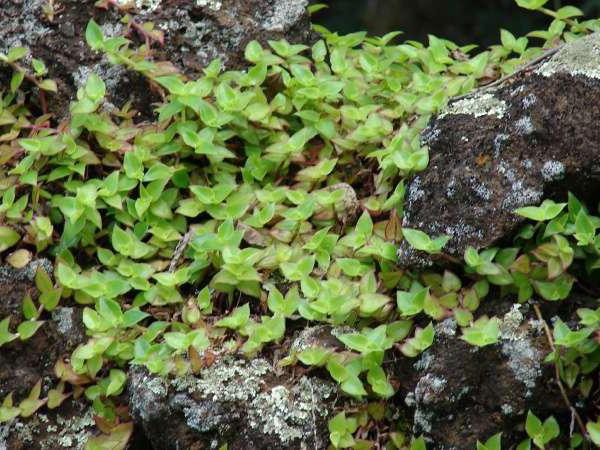

Callisia transplant
To make the bush look decorative, callisia is recommended to be grown for a couple of years, and then renewed. Pruning and an annual spring transplant are used to prolong life.
The soil is preferable to a slightly acidic reaction. It is prepared from equal proportions of leaf, turf, sand and peat. So that moisture does not stagnate at the roots, it is necessary to lay drainage during planting. Cover the bottom of the container with a 3-4 cm layer of expanded clay, pebbles or small stones. Pour some soil on top and transfer the callisia with an earthen lump. Fill the voids with the substrate and press the soil firmly against the surface with your fingers, water. Take the container 2-3 cm wider and deeper than the size of the earthen coma.

